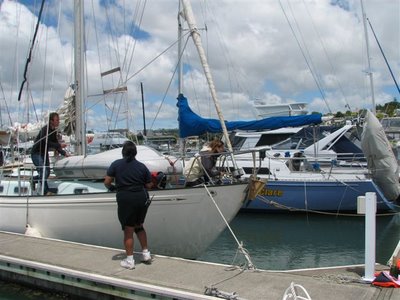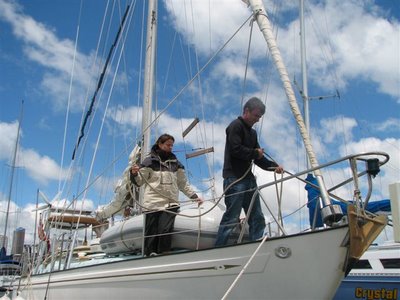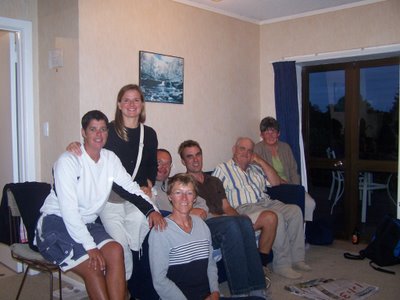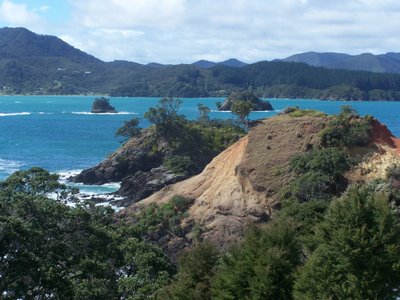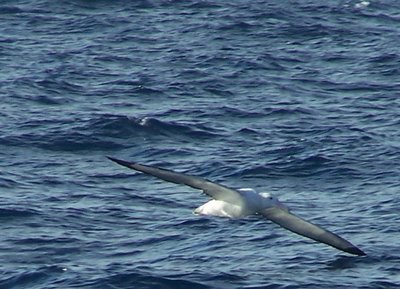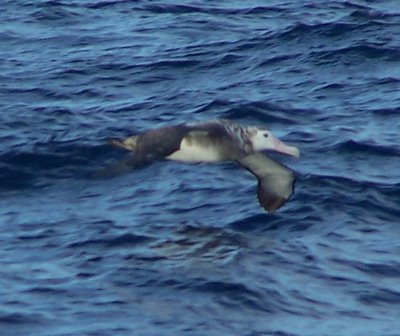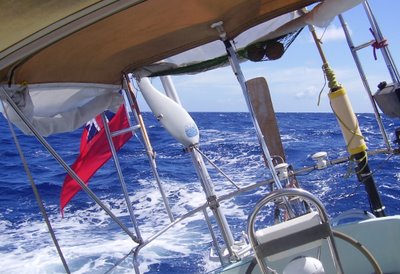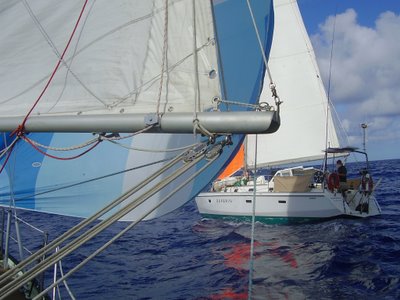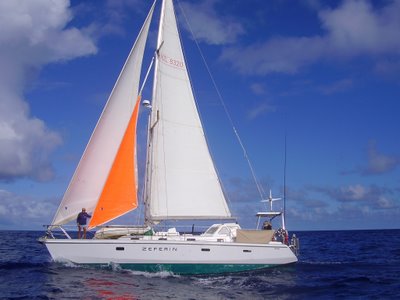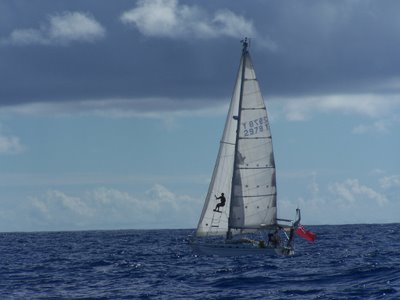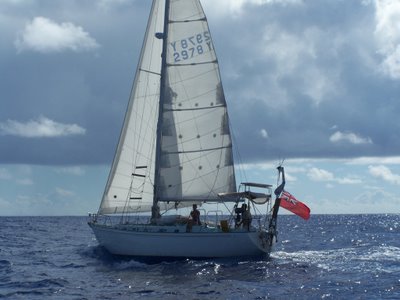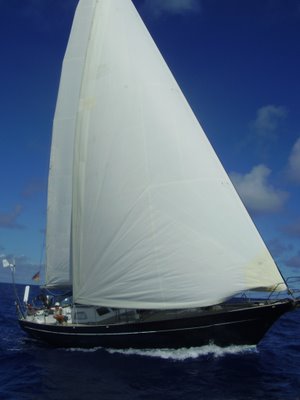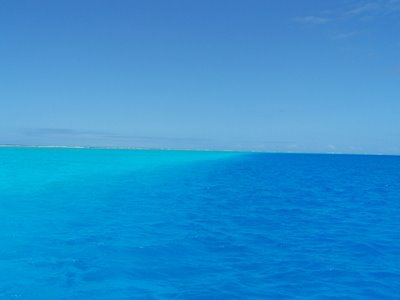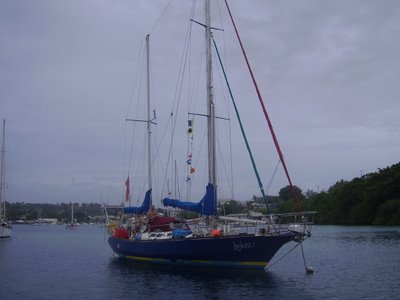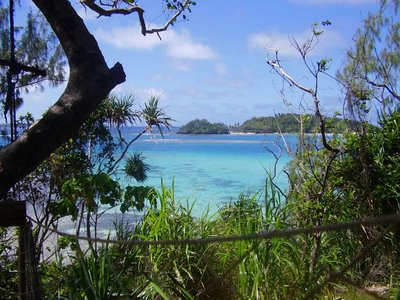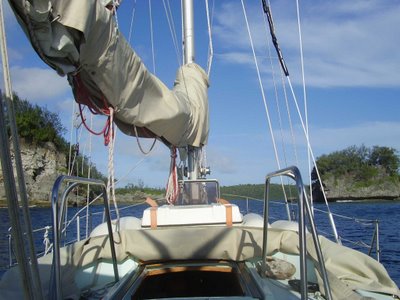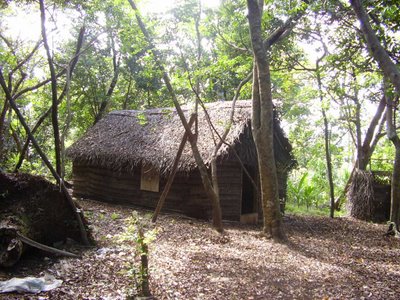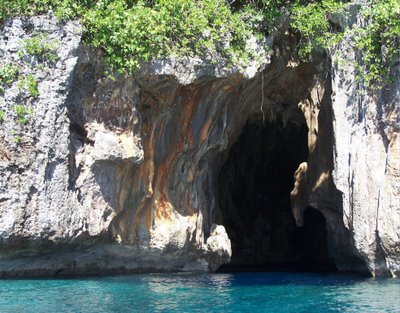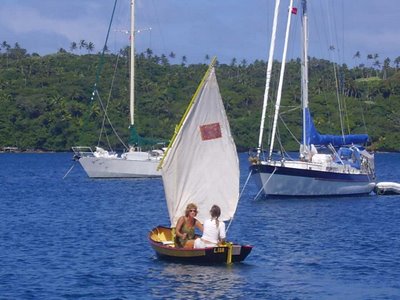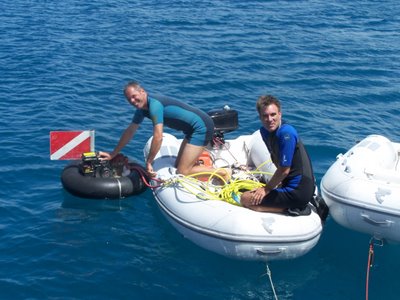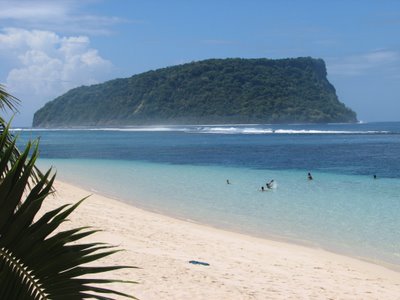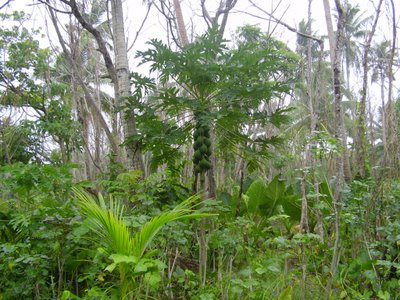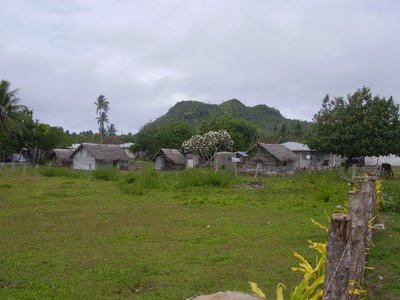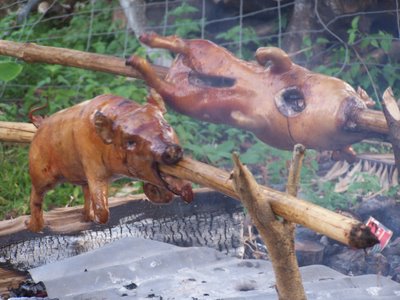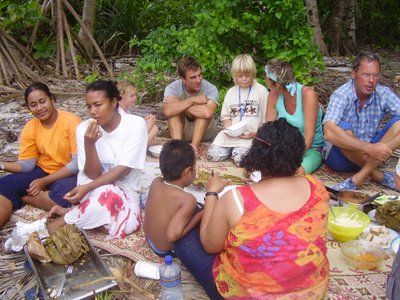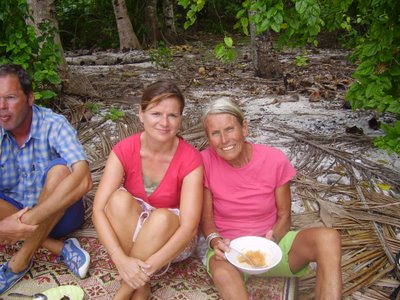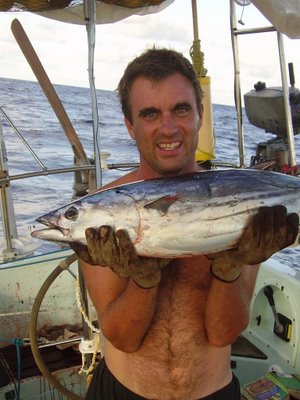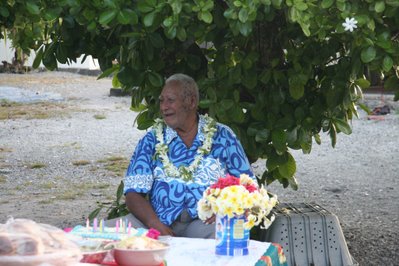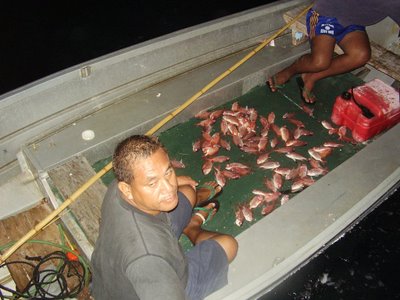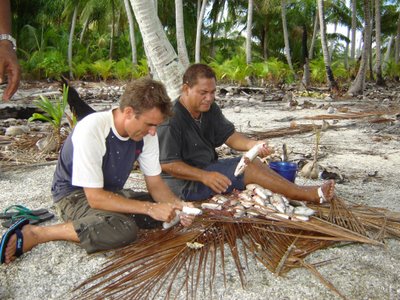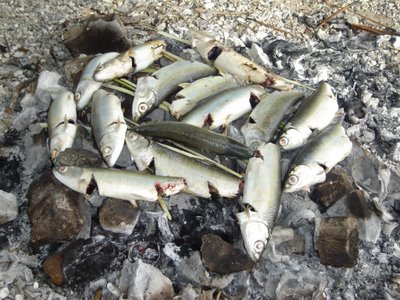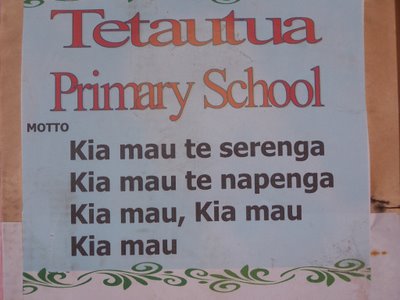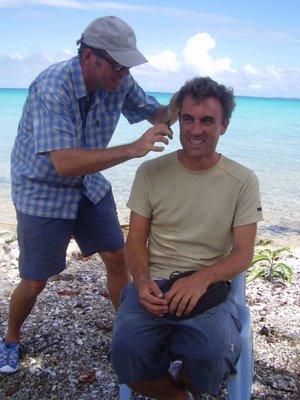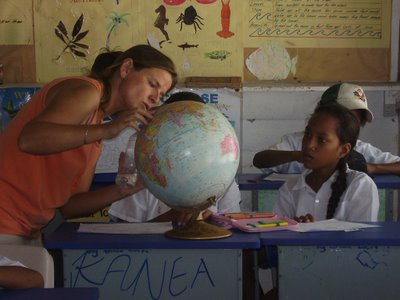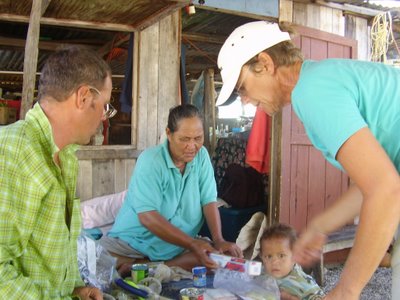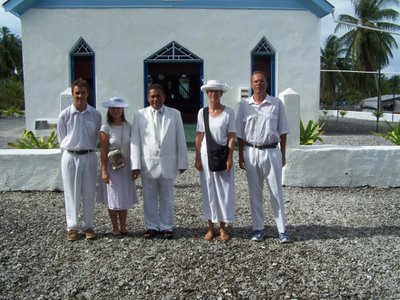So the Godfather and Godmother (not sure whose but I bet she is some lucky kids') arrived safely. At around 1.30 pm on the 12th November Kika sailed into Auckland Marina. By the time Tess, my daughter, and I had found the correct pontoon a fair sized crowd had already gathered.I assumed they were antipodean relatives of Ellen's who had just interbred a little too much but thankfully they turned out to be a group of very concerned boat owners. Nick and Ellen it seems had been making their way through the Marina in quite an erratic fashion and boaties were having to fend off Kika in order to save their own babies. Anyway Nick finally, after a year and a half, managed to master the gears and throttle and bring Kika safely (sic) into the correct berth.It looked like a sailing performance from a couple of complete novices so you can imagine the look of shock on the crowd's face when I told them that Nick and Ellen had in fact just sailed half way round the world. Some of them crossed their chests and praised the lord, some knelt down and wept and thanked Jesus that their boat hadn't been sunk by Kika who at 13 tonnes (this is apparently very heavy for a yacht of her size) was not going to be taking any prisoners and some just didn't believe me and the irrefutable fact that miracles can still happen.
Anyway after that entry and a year and a half on the high seas the captain and his able sea lady looked a little shell-shocked. They needed time and drink before recovering and finding their bearings plus excuse for their entry which they attributed to the gears on the engine not engaging and finding it difficult to get Kika into reverse.How they could blame 'she' that has so valiantly looked after them through some of the world's most treacherous seas did surprise me a little but I think being isolated out on the ocean for so long can do strange things to the mind and perhaps on reflection they will take a long hard look at themselves and try to sharpen up on marina entries (something they had apparently not done since their days in Spain).Of great sadness and shock to us was obviously the news that my very own Posh and Becks (please forgive me but any visitor who sails here on a boat from England gets treated like royalty) had split up somewhere in the Pacific. I don't understand it because they looked so fantastic on arrival and were a joy to spend time with even if the story of their voyage did go on a little too long - however I would just like to reassure all relatives in England and friends all around the world that they both seem in very good spirits and just need some time alone.It may be quite a long time that they want to spend on their own but please respect their wishes and give them all your love and support. As a man of modest relationship experience I would just like to add a philosophical note here and say that it sometimes seems that those nearest and dearest to us are both the thorniest and horniest.
So Ellen is currently trying out a new mode of transport in the form of a camper van and Nick has just started to strip Kika's engine. Luckily he began this project after a fantastic weekend of sailing on Kika with me and my two boys (Charlie and Tom).Nick slept in the stern (back) of the boat, Charlie in the bow (front) and Tom and I took the deluxe double bed in the main cabin where the table drops and becomes a bed (marvellous design).Tom slept on the left (starboard) and I slept on the right (port). Now I have this awful nagging feeling that I may have got that the wrong way round but Nick isn't around to check these facts with. Anyway this evening I tried to encourage my wife to come and spend a night on the boat with me because I have always fancied having her on the table but she refused.
A huge round of applause for Auckland's very own Posh and Becks who have done something truly amazing.
Over and out from your correspondent in the antipodese.
Friday, November 24, 2006
Saturday, November 11, 2006
New Zealand arrival
As dawn broke, we could see the outline of Cape Brett on the horizon. Despite having made numerous land-falls, the first sight of land after days at sea, has yet to loose its excitement. Our first sight of New Zealand was especially thrilling.It could be that we've been anticipating this landfall throughout our Pacific trip, knowing that it's the chance to rest and recuperate (for us and Kika), with the added pleasure of meeting long-lost New Zealand friends. Then again it could be that Zeferin's enthusiasm for their homeland has infected us with talk of amazing seafood, beautiful anchorages and stunning scenery.
The weather remained calm and clear as we motored into the Bay of Islands and up the river leading to the customs dock at Opua. We were briefly joined by some passing dolphins and received a "welcome to New Zealand" from Des at Russell Radio when we called-in to update our arrival time, all adding to the growing anticipation.
Customs and quarantine were completed in a blur of officials boarding Kika, form filling, passport stamping and confiscating fresh food and Panamanian pop-corn. All very efficient, friendly and straightforward.
Though the marina looked inviting we anchored off; it seemed a shame to start paying marina fees, which we've carefully avoided since the Canaries - not difficult in the Pacific - marinas are few and far between. We completed the day in true Kiwi style thanks to Kathleen, a New Zealander we met on-board Quantum Leap, who invited us for a welcome to New Zealand "fush and chups" supper.
The following morning we found the river obscured by mist and caught sight of our breath in the cabin - a first for us since leaving the UK. We're not equiped for such weather - winter/spring clothing needs purchasing. It's certainly a change from the unrelenting sun of the tropics. Fortunately the diesel heater fixed itself (I wish that would happen more often) and as the morning sun burnt off the fog, we enjoyed the emerging view from the comfort of a cosy boat. The landscape appears to be a mix of Cornwall, Scotland and Ireland; boats swinging on moorings in estuaries bordered by soft green rolling hills. It's hard to believe we're half-way round the world - the landscape, weather and temperature are so familiar, on the other hand the birds, trees and foliage feel exotic and the accents are unmistakably antipodean.
As I write this, almost a week has passed since our arrival. We're currently heading down to Auckland to meet up with some of our New Zealand friends. We've spent the last week exploring some of the anchorages in the Bay of Islands, sampling oysters (we managed 30 each one evening), diving unsuccessfully for scallops (needed a more substantial wet-suit) and being surprised by familiar sounds and sights; sheep bleating, sea-gull calls and mobile phone ring-tones to name a few. The weather seems a little Irish, four seasons in as many hours with some horrendous gusts (50 knots briefly). Fortunately the holding has been good and our anchor has held firm.
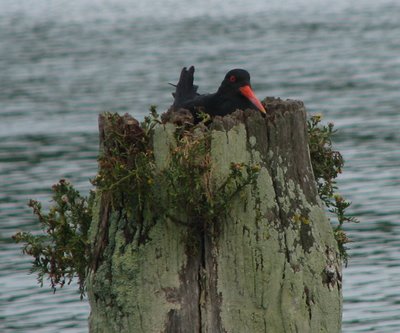

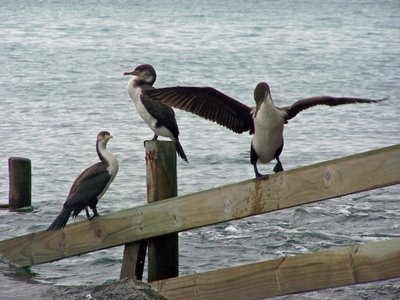
The weather remained calm and clear as we motored into the Bay of Islands and up the river leading to the customs dock at Opua. We were briefly joined by some passing dolphins and received a "welcome to New Zealand" from Des at Russell Radio when we called-in to update our arrival time, all adding to the growing anticipation.
Customs and quarantine were completed in a blur of officials boarding Kika, form filling, passport stamping and confiscating fresh food and Panamanian pop-corn. All very efficient, friendly and straightforward.
Though the marina looked inviting we anchored off; it seemed a shame to start paying marina fees, which we've carefully avoided since the Canaries - not difficult in the Pacific - marinas are few and far between. We completed the day in true Kiwi style thanks to Kathleen, a New Zealander we met on-board Quantum Leap, who invited us for a welcome to New Zealand "fush and chups" supper.
The following morning we found the river obscured by mist and caught sight of our breath in the cabin - a first for us since leaving the UK. We're not equiped for such weather - winter/spring clothing needs purchasing. It's certainly a change from the unrelenting sun of the tropics. Fortunately the diesel heater fixed itself (I wish that would happen more often) and as the morning sun burnt off the fog, we enjoyed the emerging view from the comfort of a cosy boat. The landscape appears to be a mix of Cornwall, Scotland and Ireland; boats swinging on moorings in estuaries bordered by soft green rolling hills. It's hard to believe we're half-way round the world - the landscape, weather and temperature are so familiar, on the other hand the birds, trees and foliage feel exotic and the accents are unmistakably antipodean.
As I write this, almost a week has passed since our arrival. We're currently heading down to Auckland to meet up with some of our New Zealand friends. We've spent the last week exploring some of the anchorages in the Bay of Islands, sampling oysters (we managed 30 each one evening), diving unsuccessfully for scallops (needed a more substantial wet-suit) and being surprised by familiar sounds and sights; sheep bleating, sea-gull calls and mobile phone ring-tones to name a few. The weather seems a little Irish, four seasons in as many hours with some horrendous gusts (50 knots briefly). Fortunately the holding has been good and our anchor has held firm.



meeting the locals
We're slowly adapting to a more land-based existence and we now have New Zealand numbers for our mobiles. You can contact us on:
Nick: +64 211880714
Ellen: +64 212362621
Saturday, November 04, 2006
New Zealand in Sight
It's Sunday morning and we are 20 miles from Opua. We've had a long windless night but all is well. The sea is flat and there's plenty of blue sky.
We can see Cape Brett on the north east of New Zealand and it looks very dramatic. Opua is in the Bay of Islands and we're not really sure what to expect other than lovely scenery. We don't know how commercial it is nor how busy. I'm hoping for a level of development that may include a cafe and laundry (what's new?) and if it is so developed that it has hot showers, I won't grumble. Nick is very excited because he hasn't washed his hair in 10 days and in that time, he believes it has started to 'self-clean'. Hmmmm....I fear it won't be long before this 'self-cleaning' miracle spreads to other areas such as washing up and bedlinen! Oh woe!
Most of the boats we know chose to make this their landfall, so we're hoping for some friendly faces to cheer us in. More later.
Distance to go - 20 nm
Position @ 07:38 S34°58' E174°24'
We can see Cape Brett on the north east of New Zealand and it looks very dramatic. Opua is in the Bay of Islands and we're not really sure what to expect other than lovely scenery. We don't know how commercial it is nor how busy. I'm hoping for a level of development that may include a cafe and laundry (what's new?) and if it is so developed that it has hot showers, I won't grumble. Nick is very excited because he hasn't washed his hair in 10 days and in that time, he believes it has started to 'self-clean'. Hmmmm....I fear it won't be long before this 'self-cleaning' miracle spreads to other areas such as washing up and bedlinen! Oh woe!
Most of the boats we know chose to make this their landfall, so we're hoping for some friendly faces to cheer us in. More later.
Distance to go - 20 nm
Position @ 07:38 S34°58' E174°24'
Friday, November 03, 2006
Albatross watching
It was bitterly cold last night and the morning didn't promise much of a reprieve with a grey overcast sky. We were so cold we thought we'd try the diesel cabin heater which has remained idle since we left the UK. After some time we received some warm but burnt-smelling air and hurriedly switched it off again having decided that the burning smell probably wasn't a feature. The result was we put on a few more layers and added "cabin heater" to the list of boat jobs.
During the day the sky gradually cleared and the bitterly cold wind lost its edge; perhaps we're acclimatising. We're spending more time out of the cabin and saw our first albatross.It was some distance in front of us, but had an unmistakably huge wing span and effortless flight. We're hoping for some closer encounters tomorrow with this magnificant bird.
As the skies cleared so the wind dropped, until by late afternoon we were making less than 5 knots in light winds. Fortunately there isn't much swell so the little wind there is remains in the sails. However the initial conservative estimate I gave to the NZ maritime authorities yesterday started to look optimistic so we called the authorities again with a revised (later) estimate and hope we don't keep the customs and quarantine authorities waiting on the dock for us on Sunday morning.
It's currently a calm, clear, bright moon-light night, we're making between 4 and 5 knots. It's so peaceful out here that it's difficult to imagine the same stretch of ocean as a rough and wild place that frequently causes yachts hove-to for hours while waiting for gales to pass by.
Position at 22:50 (UTC +13): S32° 39' E175° 41'
Distance to go: 158
During the day the sky gradually cleared and the bitterly cold wind lost its edge; perhaps we're acclimatising. We're spending more time out of the cabin and saw our first albatross.It was some distance in front of us, but had an unmistakably huge wing span and effortless flight. We're hoping for some closer encounters tomorrow with this magnificant bird.
As the skies cleared so the wind dropped, until by late afternoon we were making less than 5 knots in light winds. Fortunately there isn't much swell so the little wind there is remains in the sails. However the initial conservative estimate I gave to the NZ maritime authorities yesterday started to look optimistic so we called the authorities again with a revised (later) estimate and hope we don't keep the customs and quarantine authorities waiting on the dock for us on Sunday morning.
It's currently a calm, clear, bright moon-light night, we're making between 4 and 5 knots. It's so peaceful out here that it's difficult to imagine the same stretch of ocean as a rough and wild place that frequently causes yachts hove-to for hours while waiting for gales to pass by.
Position at 22:50 (UTC +13): S32° 39' E175° 41'
Distance to go: 158
Thursday, November 02, 2006
Countdown to Landfall
Today the sea has been pretty big and the waves are hitting us on the beam making the motion on Kika quite uncomfortable.It has been sunny, however, and we had fishing success this afternoon in the form of a lovely tuna. Nick was catching up on some sleep and I was relaxing with my book when the winch began to scream as the fish took the line out. Poor Nick had a rude awakening but it's nice to have some meat.
Though the radio scheds are still dominated by the weather prognoses, there is now more talk and speculation about what landfall is going to be like in NZ. Ragtime (Will and Alyssa) reached Opua in the Bay of Islands last night and say that it is really beautiful. They also mentioned that they were welcomed by several albatross and three dolphin pods. We called up the NZ coastguard today to notify them of our imminent arrival and they seemed very pleased to hear from us, so we already feel we're going to like it there. Fortunately, the weather is looking ok for the next few days with no sinister developments to speak of so let's hope it stays that way.
The drop in temperature is taking some getting used to. We haven't experienced cold like this since the spring of 2005. Suddenly my 'wardrobe' is looking very inadequate. I love the feeling though of being on watch and getting chilly, then dashing down below to warm up in my sleeping bag.
Noa and Zeferin are pretty far ahead now though we feel Kika has been making good speed. We should arrive on Sunday morning in time for Bonfire Night with is apparently celebrated on the other side of the world!
Position at 20:45 (UTC+13): S30°39' E176°52'
Daily run: 150
Distance to go to Opua: 292
Though the radio scheds are still dominated by the weather prognoses, there is now more talk and speculation about what landfall is going to be like in NZ. Ragtime (Will and Alyssa) reached Opua in the Bay of Islands last night and say that it is really beautiful. They also mentioned that they were welcomed by several albatross and three dolphin pods. We called up the NZ coastguard today to notify them of our imminent arrival and they seemed very pleased to hear from us, so we already feel we're going to like it there. Fortunately, the weather is looking ok for the next few days with no sinister developments to speak of so let's hope it stays that way.
The drop in temperature is taking some getting used to. We haven't experienced cold like this since the spring of 2005. Suddenly my 'wardrobe' is looking very inadequate. I love the feeling though of being on watch and getting chilly, then dashing down below to warm up in my sleeping bag.
Noa and Zeferin are pretty far ahead now though we feel Kika has been making good speed. We should arrive on Sunday morning in time for Bonfire Night with is apparently celebrated on the other side of the world!
Position at 20:45 (UTC+13): S30°39' E176°52'
Daily run: 150
Distance to go to Opua: 292
Tuesday, October 31, 2006
Rattle Your Dags
Today has been very special. Firstly the sailing is near perfect. We have about 10-15 knots from the East and we are on a comfortable close reach. The sea is smooth, the sky is blue but it's not too hot. Conditions have been so good, in fact, that we have been able to hoist our cruising chute once again. This always feels pretty special as though Kika's in her Sunday best. The weather prognosis also looks very benign which can only enhance our mood.
During the night on my watch, I noticed a mast-head light near on starboard aft quarter. When I checked 20 minutes later, it was on our beam and 15 minutes after that it was ahead of us. We thought there was a possibility it may be Zeferin but when we called on the VHF there was no reply so I concluded it was some kind of large super yacht judging by its pace. During our morning chat on the radio, however, it transpired that it had been Zeferin sneaking up on us in stealth mode (Joanie had 'forgotten' to turn on the VHF).I was amazed as the boat I saw had taken the lead so quickly. Anyway, they hove-to to wait for us so we could rendez-vous which we managed at about 0900.Meeting mid-ocean sounds quite pointless and dull (after all, we only said 'goodbye' to these people 4 days ago) but nothing could be further from the truth. We rarely see other boats actually under sail, and in such calm conditions we could get really close and talk to Sandy and Joan. We played around in each others' wakes for about half an hour and then they 'rattled their dags' (Kiwi term meaning 'get a move on') and were gone. It's quite sad as their landfall is not Opua but Auckland where they live, so we shall not see them when we make landfall, BUT we shall be visiting them as we've been invited to stay and sample genuine New Zealand life (I may be wrong but I think it might involve salty sea-dog talk and lots of rum.)
As Zeferin disappeared over the horizon, we just had to wait for Noa to catch us up which they eventually did at about 1600.Not content to just wave and shout at each other, Rita was determined to make physical contact and threw me a book to read on passage, and I chucked one back in return. Who says girls can't throw? Both books landed squarely in the appropriate cockpit.So now we are trailing at the rear, but it's good to know there are plenty of other boats behind us including Islay - the other Kika boat. Surely they can't overtake us can they?
It's now 9pm, the cruising chute is safely stowed and we are back to bog standard genoa and main. The wind has picked up and is jostling us about a little, so we may have to reef down soon. It's pretty cold in the evenings these days and we have broken out the sleeping bags for warmth. Seems not long ago we were struggling 24/7 to keep cool. We're hoping for another lovely day tomorrow. Meanwhile, Happy Hallowe'en!
Position @ 21:00 (GMT +13): S26° 24' E179° 21'
Daily run: 117 nmiles
Distance to go to Opua: 579 nmiles
During the night on my watch, I noticed a mast-head light near on starboard aft quarter. When I checked 20 minutes later, it was on our beam and 15 minutes after that it was ahead of us. We thought there was a possibility it may be Zeferin but when we called on the VHF there was no reply so I concluded it was some kind of large super yacht judging by its pace. During our morning chat on the radio, however, it transpired that it had been Zeferin sneaking up on us in stealth mode (Joanie had 'forgotten' to turn on the VHF).I was amazed as the boat I saw had taken the lead so quickly. Anyway, they hove-to to wait for us so we could rendez-vous which we managed at about 0900.Meeting mid-ocean sounds quite pointless and dull (after all, we only said 'goodbye' to these people 4 days ago) but nothing could be further from the truth. We rarely see other boats actually under sail, and in such calm conditions we could get really close and talk to Sandy and Joan. We played around in each others' wakes for about half an hour and then they 'rattled their dags' (Kiwi term meaning 'get a move on') and were gone. It's quite sad as their landfall is not Opua but Auckland where they live, so we shall not see them when we make landfall, BUT we shall be visiting them as we've been invited to stay and sample genuine New Zealand life (I may be wrong but I think it might involve salty sea-dog talk and lots of rum.)
As Zeferin disappeared over the horizon, we just had to wait for Noa to catch us up which they eventually did at about 1600.Not content to just wave and shout at each other, Rita was determined to make physical contact and threw me a book to read on passage, and I chucked one back in return. Who says girls can't throw? Both books landed squarely in the appropriate cockpit.So now we are trailing at the rear, but it's good to know there are plenty of other boats behind us including Islay - the other Kika boat. Surely they can't overtake us can they?
It's now 9pm, the cruising chute is safely stowed and we are back to bog standard genoa and main. The wind has picked up and is jostling us about a little, so we may have to reef down soon. It's pretty cold in the evenings these days and we have broken out the sleeping bags for warmth. Seems not long ago we were struggling 24/7 to keep cool. We're hoping for another lovely day tomorrow. Meanwhile, Happy Hallowe'en!
Kika from Zeferin
Zeferin from Kika
Noa from Kika
Position @ 21:00 (GMT +13): S26° 24' E179° 21'
Daily run: 117 nmiles
Distance to go to Opua: 579 nmiles
Monday, October 30, 2006
Reef reaching
We past north Minerva reef at dawn yesterday morning and excitedly set a new waypoint for Opua, New Zealand. Fortunately we checked the chart and realised our new course took us straight over south Minerva reef. Somewhat chastened we set a new course and past all reef dangers by 11am. It's understandable why, prior to GPS, the majority of boats gave these reefs a wide berth. Most of the reef is submerged with the occasional rock breaking the water barely allowing identification. Even our radar, which clearly picked out the Tuamotu atolls, struggled to pick up much of a target on the 6 mile range. However we both would have loved to have stopped there. The thought of being anchored in relatively calm waters, while appearing to be in the middle of the ocean would have been a unique experience ... and there's allegedly an abundance of lobsters.
The wind decreased throughout the morning until we were making less than 5 knots under full sail. As the sea was relatively calm we thought we'd try the cruising chute. We haven't made much use of it to date, as if there's much swell it tends to crash around alternatively emptying and filling. It looked like perfect light-sail weather and proved to be, easily adding another knot to our speed and helping us keep the combined challenge from Zeferin and Noa, who left Minerva that morning, at bay. It's not the most restful of sails to use, as in gusts it tends to take over from the self-steering and pull the boat off course. After a morning of manual steering and experimentation we'd tamed the sail and George (the self-steering) and the cruising chute, while not best of friends, were peacefully coexisting.
Position at 01:25 31st October (GMT +13): S25° 01' W179° 51'
Daily run: 124.0 nmiles
Distance to go to Opua: 672 nmiles
The wind decreased throughout the morning until we were making less than 5 knots under full sail. As the sea was relatively calm we thought we'd try the cruising chute. We haven't made much use of it to date, as if there's much swell it tends to crash around alternatively emptying and filling. It looked like perfect light-sail weather and proved to be, easily adding another knot to our speed and helping us keep the combined challenge from Zeferin and Noa, who left Minerva that morning, at bay. It's not the most restful of sails to use, as in gusts it tends to take over from the self-steering and pull the boat off course. After a morning of manual steering and experimentation we'd tamed the sail and George (the self-steering) and the cruising chute, while not best of friends, were peacefully coexisting.
Position at 01:25 31st October (GMT +13): S25° 01' W179° 51'
Daily run: 124.0 nmiles
Distance to go to Opua: 672 nmiles
Sunday, October 29, 2006
Closing on Minerva
The drugs have kicked in and I'm now feeling vaguely human again and able to do normal things like sitting up, eating, reading and even writing a blog instead of lying foetal on the starboard bunk for hours at a time. It's scary how effective Scopoderm is, but in such a wonderful way! Anyway, we have 60 miles to go to Minerva Reefs where we probably shan't stop as the weather window continues to look good for us, and by spending time there, we would be courting an encounter with some kind of adverse weather later in our passage. Noa and Zeferin are at anchor in the reef (they both left a day before us) and when we pass there tomorrow morning, we shall slip ahead of them in stealth mode - well sort of. We'll probably end up radioing them to say hello and they'll emerge pretty soon after and overtake us. We don't mind really, as Kika has been sailing very well and we know that what she lacks in speed she makes up for in strength (and looks!).
Today we have had more good winds from the east with lots of sunshine to help us along. It is much colder down here though, and where once a sheet was too warm at night, we are now using sleeping bags. We have spent the day chatting, cooking, reading and sleeping - the usual 'on passage' activities, with a little sailing thrown in here and there. The 'Lonely Planet' guide to New Zealand is fast becoming our most favoured piece of literature and we are getting excited about making landfall. Our destination is Opua, in the beautiful Bay of Islands, where many boats we know will have already arrived and where more will be constantly trickling in over the next few weeks. The party will be big and long!
Position @ 19:40 (30/10 UTC+13): S22° 58' W178° 09'
Distance to Minerva reef: 60 nmiles
Daily run: 136 nmiles
Today we have had more good winds from the east with lots of sunshine to help us along. It is much colder down here though, and where once a sheet was too warm at night, we are now using sleeping bags. We have spent the day chatting, cooking, reading and sleeping - the usual 'on passage' activities, with a little sailing thrown in here and there. The 'Lonely Planet' guide to New Zealand is fast becoming our most favoured piece of literature and we are getting excited about making landfall. Our destination is Opua, in the beautiful Bay of Islands, where many boats we know will have already arrived and where more will be constantly trickling in over the next few weeks. The party will be big and long!
Position @ 19:40 (30/10 UTC+13): S22° 58' W178° 09'
Distance to Minerva reef: 60 nmiles
Daily run: 136 nmiles
Saturday, October 28, 2006
Wind on the beam
We had an uneventful sail through the volcanic Ha'apai group last night. I'd been shown an old Admiralty chart which describes an island off the Ha'apai as varying in height from 50m underwater to 20m above water. Fortunately no sub-terrain volcanic action last night.
The sailing has been great so far, with 20 knots of wind on the beam making the motion much less rolly than our long downwind passages. In a confused moment after waking up today, I thought we must be at anchor such was the gentle rocking motion (Ellen disputes this). We've been making good progress as well, with a respectable 154 nautical mile daily run. However it's a while since we've been on passage and we're taking our time to adapt again. Ellen decided to try to make this passage Scopoderm patch-free, which has turned out to be a mistake. A patch is now in place and she's feeling better, hopefully she'll feel able to write an entry tomorrow.
We're 163 miles from Minerva reef and the weather is looking fairly benign so there doesn't seem much to gain in stopping. However we're still sailing in the straight-forward trade-wind belt. The winds will become less consistent in direction and force once we make it south of 25S, where the weather becomes increasingly influenced by the high and low pressure systems tracking their way from Australia to New Zealand. The trick seems to be to time our arrival in New Zealand to avoid head-winds from the leading edge of a high or trailing edge of a low, however we're still too far out to fine-tune our course.
The radar detector is beeping at us tonight, but no sign of the ship responsible. Last night it was volcanic island, tonight it's ships, it's getting colder, but no need for an iceberg watch yet.
Position @ 01:00 (29/10 UTC+13): S21° 37' W176° 58'
Distance to Minerva reef: 163 nmiles
Daily run: 154 nmiles
The sailing has been great so far, with 20 knots of wind on the beam making the motion much less rolly than our long downwind passages. In a confused moment after waking up today, I thought we must be at anchor such was the gentle rocking motion (Ellen disputes this). We've been making good progress as well, with a respectable 154 nautical mile daily run. However it's a while since we've been on passage and we're taking our time to adapt again. Ellen decided to try to make this passage Scopoderm patch-free, which has turned out to be a mistake. A patch is now in place and she's feeling better, hopefully she'll feel able to write an entry tomorrow.
We're 163 miles from Minerva reef and the weather is looking fairly benign so there doesn't seem much to gain in stopping. However we're still sailing in the straight-forward trade-wind belt. The winds will become less consistent in direction and force once we make it south of 25S, where the weather becomes increasingly influenced by the high and low pressure systems tracking their way from Australia to New Zealand. The trick seems to be to time our arrival in New Zealand to avoid head-winds from the leading edge of a high or trailing edge of a low, however we're still too far out to fine-tune our course.
The radar detector is beeping at us tonight, but no sign of the ship responsible. Last night it was volcanic island, tonight it's ships, it's getting colder, but no need for an iceberg watch yet.
Position @ 01:00 (29/10 UTC+13): S21° 37' W176° 58'
Distance to Minerva reef: 163 nmiles
Daily run: 154 nmiles
Friday, October 27, 2006
NZ here we come
It's strange how the smallest of achievements can cause a disproportionate sense of satisfaction. So it was yesterday when the (H.M) customs officer finally presented us with our clearance for New Zealand and wished us a safe trip. I left the office elated and excited at the prospect of the trip ahead. My sunny mood could been related to satisfaction at finally having made the decision to leave and acting on it. The passage to New Zealand has a reputation for nasty weather, hence synoptic charts and text forecasts receive undue attention and interpretation, strategies are expounded and "decision paralysis" starts to creep in. Then there's preparing the boat to leave; taking on water, fuel, food, servicing the engine and general essential repairs all of which can easily mean you miss the "weather window" you've divined from the charts. After our frustrations obtaining clearance in Niuatoputapu the paper chase around immigration, port-captain and customs went surprisingly smoothly.
It feels about the right time to be leaving the tropics as 1st November marks the start of the South Pacific hurricane season. The weather as usual doesn't seem aware of the official dates and produced tropical storm Xavier which, although 800 miles to our NE, has been threatening to disrupt our passage south. In practice it's impossible to predict the weather for the whole passage as it's 1200 miles to Opua, around 10 days at sea, and our synoptic charts give reasonable detail for 3 days. The weather for the remaining 7 days is really nothing more than an informed guess, based on the pattern of lows and highs passing from Australia across the Tasman sea to New Zealand. If the situation changes, we can stop in Minerva reef, 1/3 of the way there and wait for another "weather window".
Yesterday evening improved further when Matt and Togs on Helene arrived, they crossed from Galapagos to Marquesas with us, but we last saw them in the Wreck Bay in the Galapagos, it was great to catch-up and share stories.We've also met "Islay of Lorn" another Rival 38. It feels a little like Buzzlightyear in "Toy Story" coming face to face with shelves of packaged Buzzlightyears and suddenly realising he was one of many. Our friends have been loyally saying there's another "Kika" boat, and its been fascinating to compare stories and make a note of good ideas.
The official mourning period appears to be over, radio stations have switched from sombre choral music to a bizzare but entertaining mixture of 80s "classics" and rap, dancing is allowed again and "Bob's Mexican cantina" held a "Miss Vava'u" drag queen competition - shame we're off.
Up until recently it's felt like a healthy life, but in quick succession I've been struck down by a nasty cold and a swollen hand. The swelling was caused by a coral cut sustained while collecting oysters, requiring peroxide and a course of antibiotics.Both Kika and ourselves are looking forward to a rest in New Zealand.
It made a pleasant change to have a gradual transition to ocean sailing. We set sail amongst the protected waters around Vava'u and were more prepared than usual when we pointed Kika away from the islands into the ocean. We'll miss the easy sailing between tranquil anchorages broken only by the twice daily drone of the local airline's aging DC9.
It's been good sailing so far, with 15-20knots of wind on the beam - we're making 6-7 knots. All's well apart from breaking one of the self-steering lines which finally chafed through. Replacing it has been on the to-do list since the Caribbean. A quick repair only took a few minutes and Kika was actually sailing along steering herself quite happily for a while before I noticed that we weren't quite on course.
As I write this we're passing the Ha'apai group of islands, it's somewhat eerie as it's a black night and there appear to be no lights on the islands. We're keeping a good lookout as it's an area renowned for volcanic activity.
Position at 00:45(UTC+13): S19° 34' W175° 12'
Distance to Minerv reef: 320 nm
It feels about the right time to be leaving the tropics as 1st November marks the start of the South Pacific hurricane season. The weather as usual doesn't seem aware of the official dates and produced tropical storm Xavier which, although 800 miles to our NE, has been threatening to disrupt our passage south. In practice it's impossible to predict the weather for the whole passage as it's 1200 miles to Opua, around 10 days at sea, and our synoptic charts give reasonable detail for 3 days. The weather for the remaining 7 days is really nothing more than an informed guess, based on the pattern of lows and highs passing from Australia across the Tasman sea to New Zealand. If the situation changes, we can stop in Minerva reef, 1/3 of the way there and wait for another "weather window".
Yesterday evening improved further when Matt and Togs on Helene arrived, they crossed from Galapagos to Marquesas with us, but we last saw them in the Wreck Bay in the Galapagos, it was great to catch-up and share stories.We've also met "Islay of Lorn" another Rival 38. It feels a little like Buzzlightyear in "Toy Story" coming face to face with shelves of packaged Buzzlightyears and suddenly realising he was one of many. Our friends have been loyally saying there's another "Kika" boat, and its been fascinating to compare stories and make a note of good ideas.
The official mourning period appears to be over, radio stations have switched from sombre choral music to a bizzare but entertaining mixture of 80s "classics" and rap, dancing is allowed again and "Bob's Mexican cantina" held a "Miss Vava'u" drag queen competition - shame we're off.
Up until recently it's felt like a healthy life, but in quick succession I've been struck down by a nasty cold and a swollen hand. The swelling was caused by a coral cut sustained while collecting oysters, requiring peroxide and a course of antibiotics.Both Kika and ourselves are looking forward to a rest in New Zealand.
It made a pleasant change to have a gradual transition to ocean sailing. We set sail amongst the protected waters around Vava'u and were more prepared than usual when we pointed Kika away from the islands into the ocean. We'll miss the easy sailing between tranquil anchorages broken only by the twice daily drone of the local airline's aging DC9.
It's been good sailing so far, with 15-20knots of wind on the beam - we're making 6-7 knots. All's well apart from breaking one of the self-steering lines which finally chafed through. Replacing it has been on the to-do list since the Caribbean. A quick repair only took a few minutes and Kika was actually sailing along steering herself quite happily for a while before I noticed that we weren't quite on course.
As I write this we're passing the Ha'apai group of islands, it's somewhat eerie as it's a black night and there appear to be no lights on the islands. We're keeping a good lookout as it's an area renowned for volcanic activity.
Position at 00:45(UTC+13): S19° 34' W175° 12'
Distance to Minerv reef: 320 nm
Sunday, October 22, 2006
Tip Top Tonga
The final part of our passage to Vava'u seemed interminable; tacking into the wind is hard work and the rewards are meagre, but the sight of land, and a new, apparently beautiful land at that, helped to restore our spirits for the last few miles. Vava'u is a collection of fertile limestone islands surrounded by a partial reef. Those to windward have quite dramatic cliffs, while those inside the island group have gentle rounded peaks. The bases of the smaller islands have been slowly but insistently eroded by the tide, so at this juncture in their history, they resemble stout green mushrooms. The islands appear uninhabited at first but if you look carefully you can just make out the odd white church tower, red roof or puff of smoke in the hills, but the general impression is one of lush wilderness. We sailed directly west amongst the islands and made landfall in a small, perfect bay called Port Maurelle where our friends Jamie and Lucy on Savoir Vivre had promised us a right royal welcome. We had last seen them in February while moored in Bonaire and since then we'd been playing cat and mouse across the Pacific, with Savoir Vivre as the very sprightly rodent and Kika as the rather easily distracted feline. Jamie and Lucy answered our silent prayers and asked us over for beer and supper when we were ready - bliss!
Port Maurelle is a delightful anchorage with crystal clear water, fringed to the east by a small, pristine sandy beach and flanked to the north and south by banks of lush vegetation. A clear view of the Pacific lies west amongst the islands, and if you're patient, it won't take you long to spot a humpback or two out near the reef. After a snorkel the following day, we left the anchorage to make our way north to the main town, Neiafu, to check in.
The cruising here is a dream; good winds, calm waters, and countless, protected anchorages to explore amongst beautiful and varied islands. The charter company, Moorings, has a fairly large business here and as a result, they have thoroughly charted the area. Normally, this would ring negative bells of over crowded anchorages crawling with cruisers and other tourists (ugh, don't you just hate them!) but in fact Vava'u is remarkably unspoiled and we have the benefit of safe cruising in a place where we can find friends or solitude, depending on how we feel. So, on our short sail up to town, we passed 2 familiar boats with good friends aboard, and glimpsed 3 humpbacks, all in the space of 20 minutes!
Tonga is known as the 'Friendly Islands' because Captain Cook paid a visit to the island group south of here (Ha'apai) where he found the people were extremely friendly and generous, especially with their homebrew. You would have thought this may have aroused suspicion, but apparently Cook was unaware that it was all a vile plot to capture his ship and its goods, while he and his crew were in a deep drunken slumber.
The Tongan leaders, however, could not agree on strategy and the plot was abandoned due to their squabbles. Thus captain and crew escaped disaster and left with hangovers in blissful ignorance of their lucky reprieve. Perhaps because of the spurious 'friendly' reputation, the expectation is unfair, but we have met friendlier people than the Tongans. It's important to remember that their King has recently passed away, and perhaps this goes some way to explain their sobriety and seeming indifference towards us. In some ways I like it, as any bond you do make is genuine, it just may take more time and effort to make it.
We like Neiafu whose buildings scatter the hillside down to the harbour. There are many tourists here and a few ex-pats, but we have all come a long way to enjoy Vava'u for what it is and therefore there are no fancy, luxury hotels to dominate the landscape or economy. Life remains fairly simple and the small, efficient laundry cum internet cafe is civilisation enough for us and most others.
Whale-watching is big business here and it's fairly easy to find some. Many cruisers we know have swam with humpbacks which, by all accounts, are gentle and curious. This is a treat we would like to experience but we're not going chasing whales, and if the opportunity arises, we shall see how we feel. They are enormous and I'm not sure I'd feel like sharing their space with them. One wrong flick of the fluke and I'm history! The coastline here is craggy with erosion and some islands are pitted with small caves. On the north west corner of the island of Kapa is Swallows' Cave which is a tall cathedral of space full of strange and lovely rock formations.
The water below is as clear as the air above, and a beautiful light filters in from outside making it a magical place to swim in. Just a little further west on the island of Nuapapu is the unique and testing Mariners' Cave. It is roughly a sphere shaped space, half full of water but the novelty is the entrance which is about 2 metres below water level and 5 metres long. It is extremely unnerving as there is no guiding light to speak of within the cave so you must steel yourself to dive down into what appears to be solid rock. We visited it with Savoir Vivre as Jamie had been before and knew what was involved. While Nick stayed at Savoir Vivre's helm close by, Jamie, Lucy and I swam towards the cave. Jamie dived down and headed to the submerged entrance and a nervous Lucy followed (it was her first time too). I surface dived and followed in the wake of her fins, finning madly myself. Ahead I could just make out the shape of more fluorescent fins treading water in the dim light of the cave. The entrance wasn't too long but I had been very nervous and pumped like crazy to get there, so I burst through the surface into an extraordinary space to find several familiar faces all slightly distorted by their masks and their gobsmacked expressions. The cave was not as beautiful as Swallows but as the water rose and fell within, the change in pressure made the clear atmosphere turn to thick mist and back again in the space of seconds. My ears popped uncomfortably but I was elated to have made it and delighted to share the moment with some other, equally joyous friends. The exit was a beautiful, blue welcoming window of ocean and it was easy to dive down and along into the open water. When it came to Nick's turn, I led the way and though I knew where the entrance was (someone had just emerged) there were no tell-tale bright fins to guide me in. I was pretty apprehensive but determined and so I dived down. I came up into the now empty cave and Nick soon popped up beside me. This time it was lovely to have it to ourselves.
We have spent our time here enjoying wonderful sails amongst the islands, sharing 'pot lucks' on beaches with other cruisers including Joan and Walters birthdays and preparing Kika for her final leg to New Zealand.
The concept of pot luck is simple and brilliant. Get a few cruisers together, find a beach, bring along a drink and a dish, make a fire and enjoy. It gives you the opportunity to vary your palate and it's a good excuse to meet.
New Zealand immigration are notoriously stringent and will not allow many foodstuffs into the country, so we are all eking out our rations to avoid buying more only to have it confiscated when we get there. Consequently, at this stage in the trip, stocks are getting low and bilges have long been raided, so pooling our resources is wise. It's uncanny how, without any planning at all, the different dishes can complement each other. You may have stumbled across (ie stolen) a juicy papaya and a coconut on a walk earlier in the day, and the guys anchored next to you may have been fishing and caught an octopus, hence octopus curry with papaya in coconut milk on the side. I get so excited about all the possible different flavours that I still haven't learned not to put too much on my plate and Nick has announced, rather rudely I think, that he will no longer accept my leftovers. Hmmm!
In preparation for the trip south, Nick and Walter (Noa) spent part of Saturday cleaning the underside of the boats with the help of Zeferin's 'Super Snorkel'; a kind of bizarre breathing apparatus comprised of a lawnmower engine, driving a compressor which feeds 2 air tubes. It sits on the deck doing its stuff, while you take one of the tubes and do your stuff without having to surface gasping for breath every 30 seconds.
It makes hull cleaning so much easier and it's also quite good fun. Zeferin and Noa had bottoms which were thick with tenacious weed, but Kika's was pretty spotless - a testament to the outrageously expensive anti-fouling we bought back in Curacao. This may sound like a good thing, but it does in fact mean that Zeferin's and Noa's speed will now increase considerably (like they need it!) while Kika will not be going any faster because she's already been going top speed. Poor Kikes! I have been repairing the headsail which seems to get more tatty and frayed with every passage. It's frightening how much wear and tear the boat takes on these trips. If you did nothing, the boat would surely start to fall apart before your eyes. The cruising fraternity here are almost without exception hoping to head to New Zealand within the next couple of weeks. It's a tricky passage and a good weather window is essential. Consequently, here in this paradise we are becoming increasingly worked up about highs, lows, fronts, troughs, convergence zones and now, tropical storm Xavier who has reared his ugly head.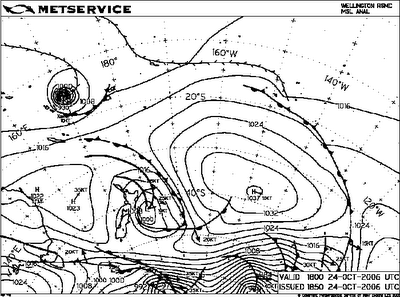
Port Maurelle is a delightful anchorage with crystal clear water, fringed to the east by a small, pristine sandy beach and flanked to the north and south by banks of lush vegetation. A clear view of the Pacific lies west amongst the islands, and if you're patient, it won't take you long to spot a humpback or two out near the reef. After a snorkel the following day, we left the anchorage to make our way north to the main town, Neiafu, to check in.
The cruising here is a dream; good winds, calm waters, and countless, protected anchorages to explore amongst beautiful and varied islands. The charter company, Moorings, has a fairly large business here and as a result, they have thoroughly charted the area. Normally, this would ring negative bells of over crowded anchorages crawling with cruisers and other tourists (ugh, don't you just hate them!) but in fact Vava'u is remarkably unspoiled and we have the benefit of safe cruising in a place where we can find friends or solitude, depending on how we feel. So, on our short sail up to town, we passed 2 familiar boats with good friends aboard, and glimpsed 3 humpbacks, all in the space of 20 minutes!
Tonga is known as the 'Friendly Islands' because Captain Cook paid a visit to the island group south of here (Ha'apai) where he found the people were extremely friendly and generous, especially with their homebrew. You would have thought this may have aroused suspicion, but apparently Cook was unaware that it was all a vile plot to capture his ship and its goods, while he and his crew were in a deep drunken slumber.
The Tongan leaders, however, could not agree on strategy and the plot was abandoned due to their squabbles. Thus captain and crew escaped disaster and left with hangovers in blissful ignorance of their lucky reprieve. Perhaps because of the spurious 'friendly' reputation, the expectation is unfair, but we have met friendlier people than the Tongans. It's important to remember that their King has recently passed away, and perhaps this goes some way to explain their sobriety and seeming indifference towards us. In some ways I like it, as any bond you do make is genuine, it just may take more time and effort to make it.
We like Neiafu whose buildings scatter the hillside down to the harbour. There are many tourists here and a few ex-pats, but we have all come a long way to enjoy Vava'u for what it is and therefore there are no fancy, luxury hotels to dominate the landscape or economy. Life remains fairly simple and the small, efficient laundry cum internet cafe is civilisation enough for us and most others.
Whale-watching is big business here and it's fairly easy to find some. Many cruisers we know have swam with humpbacks which, by all accounts, are gentle and curious. This is a treat we would like to experience but we're not going chasing whales, and if the opportunity arises, we shall see how we feel. They are enormous and I'm not sure I'd feel like sharing their space with them. One wrong flick of the fluke and I'm history! The coastline here is craggy with erosion and some islands are pitted with small caves. On the north west corner of the island of Kapa is Swallows' Cave which is a tall cathedral of space full of strange and lovely rock formations.
The water below is as clear as the air above, and a beautiful light filters in from outside making it a magical place to swim in. Just a little further west on the island of Nuapapu is the unique and testing Mariners' Cave. It is roughly a sphere shaped space, half full of water but the novelty is the entrance which is about 2 metres below water level and 5 metres long. It is extremely unnerving as there is no guiding light to speak of within the cave so you must steel yourself to dive down into what appears to be solid rock. We visited it with Savoir Vivre as Jamie had been before and knew what was involved. While Nick stayed at Savoir Vivre's helm close by, Jamie, Lucy and I swam towards the cave. Jamie dived down and headed to the submerged entrance and a nervous Lucy followed (it was her first time too). I surface dived and followed in the wake of her fins, finning madly myself. Ahead I could just make out the shape of more fluorescent fins treading water in the dim light of the cave. The entrance wasn't too long but I had been very nervous and pumped like crazy to get there, so I burst through the surface into an extraordinary space to find several familiar faces all slightly distorted by their masks and their gobsmacked expressions. The cave was not as beautiful as Swallows but as the water rose and fell within, the change in pressure made the clear atmosphere turn to thick mist and back again in the space of seconds. My ears popped uncomfortably but I was elated to have made it and delighted to share the moment with some other, equally joyous friends. The exit was a beautiful, blue welcoming window of ocean and it was easy to dive down and along into the open water. When it came to Nick's turn, I led the way and though I knew where the entrance was (someone had just emerged) there were no tell-tale bright fins to guide me in. I was pretty apprehensive but determined and so I dived down. I came up into the now empty cave and Nick soon popped up beside me. This time it was lovely to have it to ourselves.
We have spent our time here enjoying wonderful sails amongst the islands, sharing 'pot lucks' on beaches with other cruisers including Joan and Walters birthdays and preparing Kika for her final leg to New Zealand.
Joan's Birthday video
Walter's Birthday video
The concept of pot luck is simple and brilliant. Get a few cruisers together, find a beach, bring along a drink and a dish, make a fire and enjoy. It gives you the opportunity to vary your palate and it's a good excuse to meet.
New Zealand immigration are notoriously stringent and will not allow many foodstuffs into the country, so we are all eking out our rations to avoid buying more only to have it confiscated when we get there. Consequently, at this stage in the trip, stocks are getting low and bilges have long been raided, so pooling our resources is wise. It's uncanny how, without any planning at all, the different dishes can complement each other. You may have stumbled across (ie stolen) a juicy papaya and a coconut on a walk earlier in the day, and the guys anchored next to you may have been fishing and caught an octopus, hence octopus curry with papaya in coconut milk on the side. I get so excited about all the possible different flavours that I still haven't learned not to put too much on my plate and Nick has announced, rather rudely I think, that he will no longer accept my leftovers. Hmmm!
In preparation for the trip south, Nick and Walter (Noa) spent part of Saturday cleaning the underside of the boats with the help of Zeferin's 'Super Snorkel'; a kind of bizarre breathing apparatus comprised of a lawnmower engine, driving a compressor which feeds 2 air tubes. It sits on the deck doing its stuff, while you take one of the tubes and do your stuff without having to surface gasping for breath every 30 seconds.
It makes hull cleaning so much easier and it's also quite good fun. Zeferin and Noa had bottoms which were thick with tenacious weed, but Kika's was pretty spotless - a testament to the outrageously expensive anti-fouling we bought back in Curacao. This may sound like a good thing, but it does in fact mean that Zeferin's and Noa's speed will now increase considerably (like they need it!) while Kika will not be going any faster because she's already been going top speed. Poor Kikes! I have been repairing the headsail which seems to get more tatty and frayed with every passage. It's frightening how much wear and tear the boat takes on these trips. If you did nothing, the boat would surely start to fall apart before your eyes. The cruising fraternity here are almost without exception hoping to head to New Zealand within the next couple of weeks. It's a tricky passage and a good weather window is essential. Consequently, here in this paradise we are becoming increasingly worked up about highs, lows, fronts, troughs, convergence zones and now, tropical storm Xavier who has reared his ugly head.

weather fax: tropical storm Xavier - NNW of New Zealand
We'll keep you posted.
Tuesday, October 03, 2006
Apia to Vava'u
Apia gave us the chance to restock after eating and trading most of the edible items on-board in Penrhyn and during the 1400+ mile passage from Bora Bora. For the first time we took on bonded stores - the best deal was “Potter's premium rum” at just over £2 per litre - even if we end up using it to light fires we feel we've got a good deal.Samoa felt like a return to civilisation again and fortunately an affordable civilisation after the ruinous cost of French Polynesia. It's surprising how quickly initially startling sights become assimilated and so it was for the Samoan male outfit - the lava lava or ... skirt. Surprise quickly gave way to admiration for the elegance and practicality of the outfit. Why have women kept this secret from men for so long? Isn't David Beckham a closet skirt wearer? Perhaps its worth while following Beckham's clothing innovations - where does Ellen keep those "Hello" magazines....?
As well as taking a trip round the island, hiking to Robert Louis Stevenson's grave, sampling the bars and restaurants, and finding our way round the veg market, our time in Apia was enjoyably sociable. We were reunited with Zeferin, and Revision II our Pacific crossing partners as well as Noa and Quantum Leap our companions in Penrhyn. Zeferin had been stuck in Apia for two weeks already, waiting for engine spares. They were ready to leave when Sandy was immobilised by a coral infection which quickly spread throughout his leg and it took the island's strongest antibiotics to return him to his usual sprightly self. Ellen spent time with Zeferin's grand-children, snorkelling amongst huge clams in a nearly marine park while I made progress with some more pressing boat jobs.
The "award winning" "Samoa Observer" is an English language paper which we bought in the hope it would give some insight into island life. Lead stories included:
One evening we headed out to a Aggie Grey's, a famous local hotel, to see some "traditional" Samoan dance. Normally this isn't the kind of thing we search-out, but a reasonably priced eat-as-much-as-you-like buffet proved too much to resist. I went with added trepidation as I spent a disproportionate period of my student days in a pub named Aggie Grey's. Fortunately the Samoan Aggie Grey's as well as being physically half way round the world was also as far removed from its Southampton namesake. Beautiful dancing in a stunning hall provided the backdrop for the food. We tried the local delicacies; taro leaves with chicken, sea urchin roe (tasted a little of oyster), local clams – all pretty good and they provided us with more ideas for our 'hunting-gathering' trips. A good evening that, like in my student days, took us a day to fully recover from.
In Apia we started a second front on our resident cockroaches. Our first campaign in Polynesia appeared to have been a success, but it transpired that a new generation had been laid and were waiting for us to drop our vigilance before emerging. We searched the town for WMCDs (weapons of mass cockroach destruction) and returned armed with a new can of Mortein, "now with egg kill" and 24 "Lure'n Kill" cockroach baits. All have been deployed and we're spotting an increasing number of dead cockroaches, but are planning a cockroach bomb in New Zealand which will leave the boat uninhabitable for 24 hours; hopefully for the roaches as well as us.
We finally dragged ourselves away from Apia at 9.30 on 24th September for the 190 mile trip to Nuitoputapu, the most northern Tongan island. We planned to arrive before dark the following day which would mean we'd need to average around 6 knots. We set off well with 20-25 knots easterly wind and Kika comfortably making 6.5 knots with 2 reefs in the main - perfect conditions for making landfall before dusk. However the plan quickly started to unravel when we reached the west point of the Upolu and found ourselves with a counter-current creating a disturbed sea and head-winds, reducing our speed to less than 4 knots made good. Rather than continue to beat into the wind we decided to burn some of our duty-free diesel and motored for a couple of hours until we were out of the lee of the island. Slowly the wind backed to the SE and picked up, and now under full sail we made 4.5-5 knots towards our destination. At our 6pm radio schedule, we had 149 miles to go and little sign of more wind so it looked as though we'd have to spend another night at sea. Fortunately the wind continued to increase until the early hours when it settled to a steady 25 knots, although the ferocity of the squalls continued to increase and we ended the night with 3 reefs in the main and a much reduced genoa beating into a large sea but making a good 7 knots towards Tonga. By our 7am radio schedule we had 65 miles to go, and were looking good for a day-light landfall. The wind continued to play tricks; veering to the south, so we couldn't lay our course to the island, but eventually backed again so we could ease the sails slightly to a fine reach. It all felt a little like a hard beat across the Thames estuary although at least the regular drenching was pleasantly warm. We arrived at 6pm wet through, wind-beaten and deafened but elated to be in before dusk.
Our trip had taken us across the dateline, Samoa uses UT-11, Tonga UT+13. We'd set off on Sunday morning the trip took 32 hours but arrived Tuesday evening, we lost a day and a not a bad day to lose if it was anything like the preceding day.
Noa and Zeferin arrived the next day, after a harder trip than ours; they had winds gusting up to 45 knots and looked thoroughly shattered. We were welcomed into the lagoon by turtles and the crew of Quantum Leap.
Our first sample of Tonga was mixed; a beautiful island, with three villages and much cultivation, but it appeared to be the least developed of all the islands we've visited. The island supply ship was a month overdue and supplies were starting to run low, although with the profusion of fruit and fish I doubt anyone was going to starve.Many of the huts in the village are built from local materials, there were pigs running around the village and whales blowing outside the reef.It should have been idyllic, but somehow the continued wet weather, our weariness and the friendly reserve by the Tongans meant we didn't fully engage with the people in the way we had in Penrhyn. That said we were invited to a barbeque and a Sunday "pot-luck" on a motu. The barbeque consisted of two piglets on a spit, roasted over a fire and some largely inedible (at least to our palates) taro.The resulting pork looked great, and some of the meat was deliciously tender, but the vast majority was a little too fatty – perhaps we've just been spoilt by too much fresh sea-food.For the motu "pot-luck" we thought we should take sufficient of our own offerings to ensure we weren't forced by hunger into trying taro again. We took a mango tart (mangoes from a 'hunting-gathering' trip), falafel and coleslaw.In addition to the taro offering we were treated to stewed papaya and fish soaked in coconut juice with taro leaves, wrapped in banana leaves and baked in an omu (a pit filled with embers, in which the parcels of food are buried), both delicious.
On our second evening we felt a strange vibration through Kika, as though she'd suddenly turned to jelly and was being shaken from the bow. The following day we learned there'd been a large (6.5) undersea volcanic eruption a couple of hundred miles away. A tsunami warning had been issued but thankfully withdrawn. We'd heard stories of islands appearing and disappearing in this area, and the chart has caution areas marked “warning volcanic activity reported 2001”. Something to avoid.
During our stay in Nuitoputapu, the 180 mile trip due south to next island group was never far from our minds. A southerly wind continued to howl through the anchorage and many of the boats had been stuck waiting for an easterly shift for over a week. We didn't fancy another battering like the one we'd received from Samoa so much time was spent discussing the outlook and examining the forecasts. Eventually the winds shifted to the east and then to the north which was too good an opportunity to miss. So Sunday night was spent preparing for an early Monday departure. I spent the night listening to torrential rain and fretting over the passage south. The rain cleared in the morning but left the dinghy half filled and barely floating. An overflowing bucket indicated over 10 inches of rain. Before leaving we need clearance for Vava'u. Tonga is one of the countries that requires yachts to obtain clearance between island groups. We thought we arranged for Bessie, the local customs official, to arrive at 9.30 to give us the paper we needed. By 10.30 we called and were assured that she'd be there by 11. At 11.30 we called again, all knowledge was denied of previous arrangements, but she kept her third promise and arrived just after 12. This delayed our departure until 1pm and meant we had little hope of making Vava'u before nightfall the following day. My mood was blackened further when the exhaust sprang another leak as we left and I was reminded of my previous frustrations attempting repairs. However the clouds had cleared, the water around in the reef looked magnificent and a whale and calf put on a spouting and tail slapping display as we cleared the northern end of the island.
The northern wind was light, meaning we were making around 5 knots for most of the day, but with little chance to arrive before dark. Fortunately Sandy has sailed in Tonga a couple of times before and knew an anchorage which was relatively coral-free and should be possible to enter with a good moon and judicious use of radar. Given our speed our ETA was around 2am. Then at 4pm the wind shifted rapidly to the south. The unusual northerly wind was being caused by a low pressure system south of Tonga, this system was moving east-wards and would eventually bring the wind through the south before the standard SE flow re-established itself. However we didn't expect it to happen so quickly. At our 6pm radio schedule, Noa were just arriving, they'd set off four hours before us having extracted their clearance on Friday, but Zeferin and us were left with head-winds and a frustratingly close 45 miles to go. We cursed Bessie as we tacked back and forth all night making barely 15 miles towards Vava'u for all our efforts – we appeared to be affected by an adverse tide and we've yet to perfect tuning the self-steering to steer as close to the wind as we'd like.
This morning with 30 miles still to go, and a dying wind we decided to test my latest exhaust fix and motor the rest of the way.
At the time of writing (11.00am) we have 12 miles to go and no signs of asphyxiation.
As well as taking a trip round the island, hiking to Robert Louis Stevenson's grave, sampling the bars and restaurants, and finding our way round the veg market, our time in Apia was enjoyably sociable. We were reunited with Zeferin, and Revision II our Pacific crossing partners as well as Noa and Quantum Leap our companions in Penrhyn. Zeferin had been stuck in Apia for two weeks already, waiting for engine spares. They were ready to leave when Sandy was immobilised by a coral infection which quickly spread throughout his leg and it took the island's strongest antibiotics to return him to his usual sprightly self. Ellen spent time with Zeferin's grand-children, snorkelling amongst huge clams in a nearly marine park while I made progress with some more pressing boat jobs.
The "award winning" "Samoa Observer" is an English language paper which we bought in the hope it would give some insight into island life. Lead stories included:
- Death of the Tongan King Taufa'ahau
- Crack down on buses playing music too loudly
- Much debate over whether the recent anointed Miss Samoa should be stripped of her title when she turned out to be a day under-age.
- 341 days to go to the South Pacific Games to be held in Samoa - see www.samoa2007.ws
- An intriguing report titled, "PM ask UN defer LDC graduation" which transpired that the prime-minister had asked the UN to allow Samoa to keep it in the group of "Least Developed Countries" the report infered it was so Somoa could still access cheap loans.
One evening we headed out to a Aggie Grey's, a famous local hotel, to see some "traditional" Samoan dance. Normally this isn't the kind of thing we search-out, but a reasonably priced eat-as-much-as-you-like buffet proved too much to resist. I went with added trepidation as I spent a disproportionate period of my student days in a pub named Aggie Grey's. Fortunately the Samoan Aggie Grey's as well as being physically half way round the world was also as far removed from its Southampton namesake. Beautiful dancing in a stunning hall provided the backdrop for the food. We tried the local delicacies; taro leaves with chicken, sea urchin roe (tasted a little of oyster), local clams – all pretty good and they provided us with more ideas for our 'hunting-gathering' trips. A good evening that, like in my student days, took us a day to fully recover from.
In Apia we started a second front on our resident cockroaches. Our first campaign in Polynesia appeared to have been a success, but it transpired that a new generation had been laid and were waiting for us to drop our vigilance before emerging. We searched the town for WMCDs (weapons of mass cockroach destruction) and returned armed with a new can of Mortein, "now with egg kill" and 24 "Lure'n Kill" cockroach baits. All have been deployed and we're spotting an increasing number of dead cockroaches, but are planning a cockroach bomb in New Zealand which will leave the boat uninhabitable for 24 hours; hopefully for the roaches as well as us.
We finally dragged ourselves away from Apia at 9.30 on 24th September for the 190 mile trip to Nuitoputapu, the most northern Tongan island. We planned to arrive before dark the following day which would mean we'd need to average around 6 knots. We set off well with 20-25 knots easterly wind and Kika comfortably making 6.5 knots with 2 reefs in the main - perfect conditions for making landfall before dusk. However the plan quickly started to unravel when we reached the west point of the Upolu and found ourselves with a counter-current creating a disturbed sea and head-winds, reducing our speed to less than 4 knots made good. Rather than continue to beat into the wind we decided to burn some of our duty-free diesel and motored for a couple of hours until we were out of the lee of the island. Slowly the wind backed to the SE and picked up, and now under full sail we made 4.5-5 knots towards our destination. At our 6pm radio schedule, we had 149 miles to go and little sign of more wind so it looked as though we'd have to spend another night at sea. Fortunately the wind continued to increase until the early hours when it settled to a steady 25 knots, although the ferocity of the squalls continued to increase and we ended the night with 3 reefs in the main and a much reduced genoa beating into a large sea but making a good 7 knots towards Tonga. By our 7am radio schedule we had 65 miles to go, and were looking good for a day-light landfall. The wind continued to play tricks; veering to the south, so we couldn't lay our course to the island, but eventually backed again so we could ease the sails slightly to a fine reach. It all felt a little like a hard beat across the Thames estuary although at least the regular drenching was pleasantly warm. We arrived at 6pm wet through, wind-beaten and deafened but elated to be in before dusk.
Our trip had taken us across the dateline, Samoa uses UT-11, Tonga UT+13. We'd set off on Sunday morning the trip took 32 hours but arrived Tuesday evening, we lost a day and a not a bad day to lose if it was anything like the preceding day.
Noa and Zeferin arrived the next day, after a harder trip than ours; they had winds gusting up to 45 knots and looked thoroughly shattered. We were welcomed into the lagoon by turtles and the crew of Quantum Leap.
Our first sample of Tonga was mixed; a beautiful island, with three villages and much cultivation, but it appeared to be the least developed of all the islands we've visited. The island supply ship was a month overdue and supplies were starting to run low, although with the profusion of fruit and fish I doubt anyone was going to starve.Many of the huts in the village are built from local materials, there were pigs running around the village and whales blowing outside the reef.It should have been idyllic, but somehow the continued wet weather, our weariness and the friendly reserve by the Tongans meant we didn't fully engage with the people in the way we had in Penrhyn. That said we were invited to a barbeque and a Sunday "pot-luck" on a motu. The barbeque consisted of two piglets on a spit, roasted over a fire and some largely inedible (at least to our palates) taro.The resulting pork looked great, and some of the meat was deliciously tender, but the vast majority was a little too fatty – perhaps we've just been spoilt by too much fresh sea-food.For the motu "pot-luck" we thought we should take sufficient of our own offerings to ensure we weren't forced by hunger into trying taro again. We took a mango tart (mangoes from a 'hunting-gathering' trip), falafel and coleslaw.In addition to the taro offering we were treated to stewed papaya and fish soaked in coconut juice with taro leaves, wrapped in banana leaves and baked in an omu (a pit filled with embers, in which the parcels of food are buried), both delicious.
On our second evening we felt a strange vibration through Kika, as though she'd suddenly turned to jelly and was being shaken from the bow. The following day we learned there'd been a large (6.5) undersea volcanic eruption a couple of hundred miles away. A tsunami warning had been issued but thankfully withdrawn. We'd heard stories of islands appearing and disappearing in this area, and the chart has caution areas marked “warning volcanic activity reported 2001”. Something to avoid.
During our stay in Nuitoputapu, the 180 mile trip due south to next island group was never far from our minds. A southerly wind continued to howl through the anchorage and many of the boats had been stuck waiting for an easterly shift for over a week. We didn't fancy another battering like the one we'd received from Samoa so much time was spent discussing the outlook and examining the forecasts. Eventually the winds shifted to the east and then to the north which was too good an opportunity to miss. So Sunday night was spent preparing for an early Monday departure. I spent the night listening to torrential rain and fretting over the passage south. The rain cleared in the morning but left the dinghy half filled and barely floating. An overflowing bucket indicated over 10 inches of rain. Before leaving we need clearance for Vava'u. Tonga is one of the countries that requires yachts to obtain clearance between island groups. We thought we arranged for Bessie, the local customs official, to arrive at 9.30 to give us the paper we needed. By 10.30 we called and were assured that she'd be there by 11. At 11.30 we called again, all knowledge was denied of previous arrangements, but she kept her third promise and arrived just after 12. This delayed our departure until 1pm and meant we had little hope of making Vava'u before nightfall the following day. My mood was blackened further when the exhaust sprang another leak as we left and I was reminded of my previous frustrations attempting repairs. However the clouds had cleared, the water around in the reef looked magnificent and a whale and calf put on a spouting and tail slapping display as we cleared the northern end of the island.
The northern wind was light, meaning we were making around 5 knots for most of the day, but with little chance to arrive before dark. Fortunately Sandy has sailed in Tonga a couple of times before and knew an anchorage which was relatively coral-free and should be possible to enter with a good moon and judicious use of radar. Given our speed our ETA was around 2am. Then at 4pm the wind shifted rapidly to the south. The unusual northerly wind was being caused by a low pressure system south of Tonga, this system was moving east-wards and would eventually bring the wind through the south before the standard SE flow re-established itself. However we didn't expect it to happen so quickly. At our 6pm radio schedule, Noa were just arriving, they'd set off four hours before us having extracted their clearance on Friday, but Zeferin and us were left with head-winds and a frustratingly close 45 miles to go. We cursed Bessie as we tacked back and forth all night making barely 15 miles towards Vava'u for all our efforts – we appeared to be affected by an adverse tide and we've yet to perfect tuning the self-steering to steer as close to the wind as we'd like.
This morning with 30 miles still to go, and a dying wind we decided to test my latest exhaust fix and motor the rest of the way.
At the time of writing (11.00am) we have 12 miles to go and no signs of asphyxiation.
Friday, September 15, 2006
Landfall in Apia, Samoa
We made landfall early yesterday morning. From the open sea, the anchorage looked very welcoming and the leading lights were clearly visible so we decided an entry in darkness was possible. We motored quietly in (well, as quietly as we can with our engine) and checked out the shapes of familiar hulls (Revision II, Zeferin and Noa amongst others) before we found our spot and dropped anchor.We woke to the strains of 'Glory, glory Alleluja' in brass band style as the local constabulary did their 0800 parade. Apia is a sight for sore eyes after the solitude and simplicity of Penrhyn. It's a busy but attractive town nestling between gentle slopes of tropical vegetation. Checking in was a joy as we made our way around the town to visit the various very friendly officials. There's all we need here including ice cream, internet and laundry. First impressions suggest an interesting place and very different from our last stop - we'll let you know.
Wednesday, September 13, 2006
Electric Storms
We've had a great sail so far; 15-20 knots of wind and a following sea. We barely touched the sails for the first five days, but finally roused ourselves yesterday to bring our course back towards Apia, by taking the pole down and changing from a run onto a broad-reach. Since then we've been speeding along, registering the best daily run of our little group - a respectable 153 miles, compared with 150 and 145 from Revision II and Noa. Sadly it's too little too late and when we arrive tonight the other boats will already have moved from the beer onto rum cocktails - something to look forward to then.
We set off from Penrhyn with a bright full-moon accompanying our night watches. Over the course of the passage, the moon has progressively risen later and last night in the dark, star-lit first-half of the night we were treated to spectacular flashes of lightning from a storm further north. Normally I feel uncomfortable being on a small boat with lightning flashes around. I guess I've heard too many apocryphal stories of yachts being damaged by lightning strikes, however last night we felt sufficiently far from the storm to enjoy the display from what felt like the safety of our cockpit.
Although the weather has been kind to us, making for a swift and easy passage, the trip has felt longer than the 6/7 days it'll turn out to be. When we set off I felt as though we were embarking on a quick hop between islands and hadn't prepared myself for the routine of watch-keeping and rhythm of the boat at sea. I think it's made the passage seem longer and consequently the anticipation of landfall much greater.
The fishing line will be deployed once again in the hope we can fill the fridge with a tasty wahoo before our arrival. The large tuna we caught on the first day fed us well, but its possible to have too much of a fresh fish and we were happy to finish it and move onto canned food for a change!
News has reached us of the death of the Tongan king. The cruising airwaves are full of rumours about the consequences, ranging from a half-year virtual shut-down of Tonga to a more reasonable week to two weeks of official mourning. Our correspondents in the capital, Will and Alyssa on Ragtime, report that the customs, immigration and port representative, all wore black arm-bands for their check-in yesterday but overnight the city has been transformed with shops being repainted in black and maroon, and the population dressing themselves in black. It's certainly going to be an interesting time to visit.
Position @ 7.30 local time (GMT-10): S13deg00' W170deg 19'
Distance to go: 96
We set off from Penrhyn with a bright full-moon accompanying our night watches. Over the course of the passage, the moon has progressively risen later and last night in the dark, star-lit first-half of the night we were treated to spectacular flashes of lightning from a storm further north. Normally I feel uncomfortable being on a small boat with lightning flashes around. I guess I've heard too many apocryphal stories of yachts being damaged by lightning strikes, however last night we felt sufficiently far from the storm to enjoy the display from what felt like the safety of our cockpit.
Although the weather has been kind to us, making for a swift and easy passage, the trip has felt longer than the 6/7 days it'll turn out to be. When we set off I felt as though we were embarking on a quick hop between islands and hadn't prepared myself for the routine of watch-keeping and rhythm of the boat at sea. I think it's made the passage seem longer and consequently the anticipation of landfall much greater.
The fishing line will be deployed once again in the hope we can fill the fridge with a tasty wahoo before our arrival. The large tuna we caught on the first day fed us well, but its possible to have too much of a fresh fish and we were happy to finish it and move onto canned food for a change!
News has reached us of the death of the Tongan king. The cruising airwaves are full of rumours about the consequences, ranging from a half-year virtual shut-down of Tonga to a more reasonable week to two weeks of official mourning. Our correspondents in the capital, Will and Alyssa on Ragtime, report that the customs, immigration and port representative, all wore black arm-bands for their check-in yesterday but overnight the city has been transformed with shops being repainted in black and maroon, and the population dressing themselves in black. It's certainly going to be an interesting time to visit.
Position @ 7.30 local time (GMT-10): S13deg00' W170deg 19'
Distance to go: 96
Monday, September 11, 2006
Last but not least
Well, our first 24 hours of sailing found us ahead of Noa - some achievement as they left before us and she's a fast boat, so we were quite elated about that. Today, however is a different story. They are further south than us and experiencing different weather. It seems they had good winds yesterday and last night and are now 30 miles ahead of us! Very annoying! Revision 2 are headed to Apia also, and are at the front of our little group. The competition is fun, but more than that, I like the feeling that friends are also out there. It's hard to describe what it's like when you've been on a long passage with other boats and, thanks to the radio net, you share the adventure and challenge. Then, depending who makes the best time, either you are watching out for them to make landfall, or they are waiting in the anchorage for you to arrive (preferably with a cold beer in their hand and a big laundrette in the background!) It's a unique and wonderful feeling and somehow all the trials and tribulations of the passage seem worth it. Not too many trials so far on this passage though. We had a couple of squalls yesterday and last night, but nothing major. The sea is pretty big and powerful today which always makes for more interesting viewing. I deigned to do some hand-steering this afternoon in an effort to make up some distance (the wind-vane yaws considerably) and I really enjoyed surfing down the waves. I sometimes feel the boat must surely get swamped by some of the bigger crests, but she always comes out on top.
We tuned into the net yesterday to find that disaster had struck our friends on Ragtime. They were making landfall in Tonga and were pushed onto the reef by a strong current. They spent 5 exhausting hours in the night attempting to pull the boat from the coral with the help of their dinghy and 4 anchors. Amazingly, they managed to do it, and both Will and Alyssa are ok, and Ragtime is still floating so things could be worse. We know how terrifying it must have been for them after our experience in Raroia which sounded like peanuts compared to their trauma! What I remember most from Raroia was being so grateful to Will and Alyssa for realising how dire our situation was and taking the time to talk us through our options on the net that fateful morning. We were counting down the minutes to net time, just desperate to talk to someone sensible who would reassure us and offer some objective advice, and they did. I wish we could have helped them on Friday.
We finished the fish tonight and I have seriously had enough of tuna for a while (possibly a lifetime!) Oh for a chicken breast or bacon sandwich! We know of a cruiser who put his fishing line out the other day and hooked a whale! Needless to say he lost the line!
We are currently sailing smoothly at 5-6 knots. We have the wind behind us and are 'wing on wing' ie American speak for 'goosewinging!'
Position @ 2145 local time (GMT-10): S11deg29 W164deg25
Miles to go: 450
We tuned into the net yesterday to find that disaster had struck our friends on Ragtime. They were making landfall in Tonga and were pushed onto the reef by a strong current. They spent 5 exhausting hours in the night attempting to pull the boat from the coral with the help of their dinghy and 4 anchors. Amazingly, they managed to do it, and both Will and Alyssa are ok, and Ragtime is still floating so things could be worse. We know how terrifying it must have been for them after our experience in Raroia which sounded like peanuts compared to their trauma! What I remember most from Raroia was being so grateful to Will and Alyssa for realising how dire our situation was and taking the time to talk us through our options on the net that fateful morning. We were counting down the minutes to net time, just desperate to talk to someone sensible who would reassure us and offer some objective advice, and they did. I wish we could have helped them on Friday.
We finished the fish tonight and I have seriously had enough of tuna for a while (possibly a lifetime!) Oh for a chicken breast or bacon sandwich! We know of a cruiser who put his fishing line out the other day and hooked a whale! Needless to say he lost the line!
We are currently sailing smoothly at 5-6 knots. We have the wind behind us and are 'wing on wing' ie American speak for 'goosewinging!'
Position @ 2145 local time (GMT-10): S11deg29 W164deg25
Miles to go: 450
Saturday, September 09, 2006
Riding the rapids
Yesterday we reluctantly prised ourselves away from Penrhyn for the 850 mile passage to Apia in Samoa. We could easily have spent a month there, but the weather outlook appears promising and there's still a lot to see (and miles to cover) before we head to New Zealand for the hurricane season. We planned to leave with Noa, but found our anchor chain caught under a coral ledge. After trying various untangling maneuvers we accepted the inevitable and dived to free the chain by hand. It was a fortunate that we'd become accustomed to swimming alongside black and white tip sharks during our stay as I barely noticed their presence circling not far from the offending coral head - I don't think I'd have been quite so oblivious a week ago.
By the time the chain was freed the sun was high in the sky, making it straightforward to spot the isolated coral patches on our trip back across the lagoon. As we approached the pass, it became clear that the tide was rapidly ebbing out of the lagoon and once caught by the flow there was little we could do other than aim for the deeper water in the middle and enjoy the swift ride out. Another yacht was anchored outside, waiting for slack water - she'll be the fifteenth boat to visit Penrhyn this year - a bumper year. We wished them an enjoyable stay and set course for Apia.
We've had a pleasant but slow trip so far, the sea is calm, the wind is around 8-10 knots and we've been making 3-5knots running goose-winged under full main and poled-out genoa. We were welcomed back into deep waters by a large pod of white-nosed dolphins and we landed a large tuna around sunset yesterday.
Its the first time we've had to use the gaff to land a fish. We bought the gaff way back in Gibraltar and its been patiently rusting away waiting for its moment of glory. Although we haven't been short of fresh fish during our stay, its great to start the passage with the fridge full of fish and break open the wasabi and soy sauce once again.
Position at 7.30 local time (GMT-10): S9deg 25' W159deg 27'
Distance to Apia: 769
By the time the chain was freed the sun was high in the sky, making it straightforward to spot the isolated coral patches on our trip back across the lagoon. As we approached the pass, it became clear that the tide was rapidly ebbing out of the lagoon and once caught by the flow there was little we could do other than aim for the deeper water in the middle and enjoy the swift ride out. Another yacht was anchored outside, waiting for slack water - she'll be the fifteenth boat to visit Penrhyn this year - a bumper year. We wished them an enjoyable stay and set course for Apia.
We've had a pleasant but slow trip so far, the sea is calm, the wind is around 8-10 knots and we've been making 3-5knots running goose-winged under full main and poled-out genoa. We were welcomed back into deep waters by a large pod of white-nosed dolphins and we landed a large tuna around sunset yesterday.
Its the first time we've had to use the gaff to land a fish. We bought the gaff way back in Gibraltar and its been patiently rusting away waiting for its moment of glory. Although we haven't been short of fresh fish during our stay, its great to start the passage with the fridge full of fish and break open the wasabi and soy sauce once again.
Position at 7.30 local time (GMT-10): S9deg 25' W159deg 27'
Distance to Apia: 769
Thursday, September 07, 2006
Away from Atoll!
We made landfall in Penrhyn on Tuesday 30th August, and it has been a week full of activities and discoveries - some perplexing, some delightful, all fascinating. We entered the pass easily and once we had checked in at the main village of Omoka, we motored gingerly across the lagoon to the lovely anchorage off the village of Tetautua. Here, we have received a welcome so warm and disarming, it has made us feel very special and a little awkward at times. They don't have many yachts visiting here (too far north) and have only had 14 this year to date so we are still rather a novelty. On the second night, we were invited to one of the elder's 79th birthday celebration. Most of the village was there and all the cruisers (there's 5 yachts here). Nick and I took a salad with us and added it to the mountain of food they had prepared. They had bbq'd lobsters and mackerel and, to our dismay, there was also turtle meat (they are plentiful here but it is still illegal).We were welcomed by everyone, shared prayers with them, sang 'Happy Birthday' and 'For He's a Jolly Good Fellow' to the birthday boy, and then while some of us chatted and enjoyed birthday cake, others played their instruments and sang some traditional songs. At the end of the evening my salad bowl was returned clean and full of left-over bread buns and vegetables.The following day began with a wind-surfing lesson for me from Tom on 'Quantum Leap' which was swiftly followed (I was actually picked up from the surfboard) by an exclusive trip for us with the Reverend Roy (the minister here) to the small pass to the north of the village where there is reputed to be excellent snorkeling. We dropped into the water and for a little while we shared a world with sharks (black tip and white tip), rays, Napoleon fish, barracuda and trevally, but the most startling aspect of the experience was the coral which totally dominated the seascape with its abundance and colour. There was no sand to be seen; it was as if we had swam into an underwater mountain range of coral and we felt quite small amongst the valleys and hills, peaks and cliffs.
That evening, all the male cruisers were invited by some locals to a lobster hunting expedition on the reef which sounded quite treacherous and yielded 2 lobsters before it finally had to be abandoned due to foot-injury. Some might say this was Bad Fairy Payback for not inviting the female visitors! This society is patriarchal in its traditions; women are said to bring bad luck to a fishing trip - something that Rita and I have luckily had the opportunity to disprove during our stay.
So, another day, another trip. This time the health officer, Joseph or 'OJ' to his friends, and two younger men gave up most of their day to take 4 of us (Kika and Noa) to the north of the lagoon to fish and teach us how to look for pearls and clams and to husk coconuts.The concept of time here is fairly relaxed (not a problem as it's not like we've got trains to catch) so after some delay and the usual preamble which seems obligatory before embarking on any activity here, we set off. The clams are large and abundant, and easily found in the shallow waters of the lagoon. They are on average about 8" long and the fleshy lips are beautiful iridescent colours. The nugget of muscle is tasty and a pleasant texture, and can form the basis of a good curry as Noa proved later in the week. We also opened and ate oysters straight out the shell - normal Pacific and pearl oysters or 'pee-pees'.Various methods were used to catch parrot fish, squirrel fish, milk fish and trevally which we then barbequed on a deserted motu and garnished with grated coconut. I spent time in the shallows just looking at the life on the sea-bed. You think it's all sand and rock but if you make yourself immobile and just float on the surface the place comes alive. You see shells move as the hermit crabs begin to lumber about, families of little fish poke their heads out from behind coral florets, shrimps resume endless excavations, and all the time, the black tip sharks patrol.I saw an amazing sight which I found incredible when I first read about it months ago and was amazed to witness here in Penrhyn. A small (about 2") white goby sits by a hole in the seabed. Periodically, a grey shrimp, (about 1.5") appears from the hole with its 'shovel' of pincers full of sand. The goby feeds on creatures that the shrimp disturbs with its excavations and, in return, the virtually blind shrimp relies on the goby to be its sentinel. On emerging with its load, the busy shrimp touches the goby with its antennae for reassurance. If the goby senses danger, it flicks the shrimp with its tail and both retreat hastily into the hole. How about that for a bit of mutual back-scratching! I think it's called a 'mutual symbiotic relationship', ie: both parties benefit. I actually saw this happen in 5 or 6 different places. At one point I was so engrossed that I didn't notice a blacktip almost brush past my left arm until it was there in front of me. A 'mutually impervious relationship' - at least that's what he thought (I hid my shock pretty well!)
These trips are totally dependent on the kindness and generosity of the locals who happily give up their time to show you their atoll. There is also, it must be said, a rivalry between senior members of the village to befriend cruisers. We have puzzled over the reasons for this which, as there is no material benefit to befriending us, must simply be status. This competition fuels their enthusiasm and willingness to give of their time and resources. It's important, we have quickly come to realise, not to abuse their generosity and to try to diffuse any competition by giving some time to all parties - not always easy and sometimes a little awkward. That the town is so small only exacerbates the problem. Everyone seems to know the other's business down to how many cans of beer you have bought from the town on 'The Other Side'. Omoka is a short trip across the lagoon, but the rivalry between there and Tetautua is fierce. When we arrived, though the officials who checked us in were pleasant and helpful, they implied that over on 'The Other Side' we had to beware as the people were prone to theft and other vices which is, happily, complete fiction. It reminds me of the perpetual rivalry between Grimsby and Hull which sit on opposing sides of the river Humber (the south side's the best!) This is paradise with a twist: stay for a couple of days and you see paradise, stay for a couple more and you see the twist. It seems that life in a small town has its drawbacks, whether your view is the Pacific or Pontefract. The population of the town is much depleted - there are only about 60 inhabitants these days. Jobs and adventure in Australia and New Zealand often prove difficult to resist, and as a result there are constant, valiant efforts being made to continue the dwindling traditions and culture. The language is Maori but it is a dialect which is unique to Penrhyn and is spoken throughout although English is also spoken and, of course, this has enabled greater contact between us and the locals. A group of villagers of all ages are involved in taking a tour of New Zealand and Australia where they will perform dancing, singing and traditional music in order to raise money for a new tractor. We were lucky enough to be invited to a rehearsal in the Sunday school one evening. Those performers with small children brought them along and either put them on a mat on the floor to one side where they fell asleep, or else they simply slept in their parent's arms while they belted out the songs. The singing was wonderful and accompanied by some accomplished ukulele playing. The dances were similar to other Polynesian arrangements we have seen but both the group of young girls and boys who danced seemed to enjoy it so much and were so unselfconscious and energetic, it was a delight to watch. We felt so privileged to be there and were almost speechless when the band leader stood up at the end of the rehearsal and thanked the 'yachts' for coming to listen!
In return for all the time and generosity we have been lucky to receive, we have made efforts to help in any ways we can.Nick has explained the mysteries of OJ's computer to him, Walter has, to his and our surprise, become the local barber,I spent Monday morning teaching in the local school and Rita and I have done some very satisfying 'mutually symbiotic' trading for pearls.We have cleared our lockers of useless t-shirts, sheets and towels which the locals really need, and we both have a small collection of pearls which WE really need!Sunday morning was quite special. The Cook Islanders take the Sabbath very seriously - no work at all to be done during the day (I had to hang the washing on the starboard side of the boat away from prying eyes!) We were welcome to attend the church service (the second of three services held each Sunday) at 10am but we all had to wear white, it being the first Sunday in the month which is traditionally 'White Sunday'. Apparently this dates back to missionary times when the 'whites' came and spread the word! So, of course, we had to borrow white clothes from the locals - Rita and I even had to wear hats! We actually felt very special and could understand how it gave the event significance. It could also have had something to do with the fact that they were the first clean clothes we've worn in weeks! We were formally but warmly welcomed to the church in Penrhyn dialect and in English. It was a long service but punctuated by the wonderful, unaccompanied, melodious singing.We are thinking of leaving for Samoa tomorrow. The weather looks good and though we've had a great time and will never forget the experience, it's time to go. I have set up a correspondence with the school principal here and hope to get a dialogue going between the pupils of Tetautua school and my new school, wherever that may be. We've got a lot to learn from each other.
That evening, all the male cruisers were invited by some locals to a lobster hunting expedition on the reef which sounded quite treacherous and yielded 2 lobsters before it finally had to be abandoned due to foot-injury. Some might say this was Bad Fairy Payback for not inviting the female visitors! This society is patriarchal in its traditions; women are said to bring bad luck to a fishing trip - something that Rita and I have luckily had the opportunity to disprove during our stay.
So, another day, another trip. This time the health officer, Joseph or 'OJ' to his friends, and two younger men gave up most of their day to take 4 of us (Kika and Noa) to the north of the lagoon to fish and teach us how to look for pearls and clams and to husk coconuts.The concept of time here is fairly relaxed (not a problem as it's not like we've got trains to catch) so after some delay and the usual preamble which seems obligatory before embarking on any activity here, we set off. The clams are large and abundant, and easily found in the shallow waters of the lagoon. They are on average about 8" long and the fleshy lips are beautiful iridescent colours. The nugget of muscle is tasty and a pleasant texture, and can form the basis of a good curry as Noa proved later in the week. We also opened and ate oysters straight out the shell - normal Pacific and pearl oysters or 'pee-pees'.Various methods were used to catch parrot fish, squirrel fish, milk fish and trevally which we then barbequed on a deserted motu and garnished with grated coconut. I spent time in the shallows just looking at the life on the sea-bed. You think it's all sand and rock but if you make yourself immobile and just float on the surface the place comes alive. You see shells move as the hermit crabs begin to lumber about, families of little fish poke their heads out from behind coral florets, shrimps resume endless excavations, and all the time, the black tip sharks patrol.I saw an amazing sight which I found incredible when I first read about it months ago and was amazed to witness here in Penrhyn. A small (about 2") white goby sits by a hole in the seabed. Periodically, a grey shrimp, (about 1.5") appears from the hole with its 'shovel' of pincers full of sand. The goby feeds on creatures that the shrimp disturbs with its excavations and, in return, the virtually blind shrimp relies on the goby to be its sentinel. On emerging with its load, the busy shrimp touches the goby with its antennae for reassurance. If the goby senses danger, it flicks the shrimp with its tail and both retreat hastily into the hole. How about that for a bit of mutual back-scratching! I think it's called a 'mutual symbiotic relationship', ie: both parties benefit. I actually saw this happen in 5 or 6 different places. At one point I was so engrossed that I didn't notice a blacktip almost brush past my left arm until it was there in front of me. A 'mutually impervious relationship' - at least that's what he thought (I hid my shock pretty well!)
These trips are totally dependent on the kindness and generosity of the locals who happily give up their time to show you their atoll. There is also, it must be said, a rivalry between senior members of the village to befriend cruisers. We have puzzled over the reasons for this which, as there is no material benefit to befriending us, must simply be status. This competition fuels their enthusiasm and willingness to give of their time and resources. It's important, we have quickly come to realise, not to abuse their generosity and to try to diffuse any competition by giving some time to all parties - not always easy and sometimes a little awkward. That the town is so small only exacerbates the problem. Everyone seems to know the other's business down to how many cans of beer you have bought from the town on 'The Other Side'. Omoka is a short trip across the lagoon, but the rivalry between there and Tetautua is fierce. When we arrived, though the officials who checked us in were pleasant and helpful, they implied that over on 'The Other Side' we had to beware as the people were prone to theft and other vices which is, happily, complete fiction. It reminds me of the perpetual rivalry between Grimsby and Hull which sit on opposing sides of the river Humber (the south side's the best!) This is paradise with a twist: stay for a couple of days and you see paradise, stay for a couple more and you see the twist. It seems that life in a small town has its drawbacks, whether your view is the Pacific or Pontefract. The population of the town is much depleted - there are only about 60 inhabitants these days. Jobs and adventure in Australia and New Zealand often prove difficult to resist, and as a result there are constant, valiant efforts being made to continue the dwindling traditions and culture. The language is Maori but it is a dialect which is unique to Penrhyn and is spoken throughout although English is also spoken and, of course, this has enabled greater contact between us and the locals. A group of villagers of all ages are involved in taking a tour of New Zealand and Australia where they will perform dancing, singing and traditional music in order to raise money for a new tractor. We were lucky enough to be invited to a rehearsal in the Sunday school one evening. Those performers with small children brought them along and either put them on a mat on the floor to one side where they fell asleep, or else they simply slept in their parent's arms while they belted out the songs. The singing was wonderful and accompanied by some accomplished ukulele playing. The dances were similar to other Polynesian arrangements we have seen but both the group of young girls and boys who danced seemed to enjoy it so much and were so unselfconscious and energetic, it was a delight to watch. We felt so privileged to be there and were almost speechless when the band leader stood up at the end of the rehearsal and thanked the 'yachts' for coming to listen!
In return for all the time and generosity we have been lucky to receive, we have made efforts to help in any ways we can.Nick has explained the mysteries of OJ's computer to him, Walter has, to his and our surprise, become the local barber,I spent Monday morning teaching in the local school and Rita and I have done some very satisfying 'mutually symbiotic' trading for pearls.We have cleared our lockers of useless t-shirts, sheets and towels which the locals really need, and we both have a small collection of pearls which WE really need!Sunday morning was quite special. The Cook Islanders take the Sabbath very seriously - no work at all to be done during the day (I had to hang the washing on the starboard side of the boat away from prying eyes!) We were welcome to attend the church service (the second of three services held each Sunday) at 10am but we all had to wear white, it being the first Sunday in the month which is traditionally 'White Sunday'. Apparently this dates back to missionary times when the 'whites' came and spread the word! So, of course, we had to borrow white clothes from the locals - Rita and I even had to wear hats! We actually felt very special and could understand how it gave the event significance. It could also have had something to do with the fact that they were the first clean clothes we've worn in weeks! We were formally but warmly welcomed to the church in Penrhyn dialect and in English. It was a long service but punctuated by the wonderful, unaccompanied, melodious singing.We are thinking of leaving for Samoa tomorrow. The weather looks good and though we've had a great time and will never forget the experience, it's time to go. I have set up a correspondence with the school principal here and hope to get a dialogue going between the pupils of Tetautua school and my new school, wherever that may be. We've got a lot to learn from each other.
Slide show
Subscribe to:
Posts (Atom)
